Continuous Stream Discharge, Salinity, and Associated Data Collected in the Lower St. Johns River and Its Tributaries, Florida, 2020
Links
- Document: Report (3.73 MB pdf) , HTML , XML
- Dataset: USGS National Water Information System database —USGS water data for the Nation
- Download citation as: RIS | Dublin Core
Acknowledgments
The author thanks the data collection personnel from the U.S. Geological Survey for their help collecting and analyzing the streamflow and water-quality data.
Abstract
The U.S. Army Corps of Engineers, Jacksonville District, is deepening the St. Johns River channel in Jacksonville, Florida, from 40 to 47 feet along 13 miles of the river channel beginning at the mouth of the river at the Atlantic Ocean, in order to accommodate larger, fully loaded cargo vessels. The U.S. Geological Survey, in cooperation with the U.S. Army Corps of Engineers, monitored stage, discharge, and (or) water temperature and salinity at 26 continuous data collection stations in the St. Johns River and its tributaries.
This is the fifth annual report by the U.S. Geological Survey on data collection for the Jacksonville Harbor deepening project. The report contains information pertinent to data collection during the 2020 water year, from October 2019 to September 2020. The addition of water-quality data collection at St. Johns River at Buffalo Bluff near Satsuma was the only modification to the previously installed network.
Discharge and salinity varied widely during the data collection period, which included above-average rainfall for 3 of the 5 counties in the study area. Total annual rainfall for all counties ranked third among the annual totals computed for the 5 years considered for this study. Annual mean discharge at Clapboard Creek was highest among the tributaries, followed by Ortega River, Durbin Creek, Pottsburg Creek at U.S. 90, Cedar River, Trout River, Julington Creek, Pottsburg Creek near South Jacksonville, Dunn Creek, and Broward River, whose annual mean was lowest. Annual mean discharge at 8 of the 10 tributary monitoring sites was higher for the 2020 water year than for the 2019 water year, and the computed annual mean flow at Clapboard Creek was the highest over the 5 years considered for this study. The annual mean discharge for each of the main-stem sites was higher for the 2020 water year than for the 2019 water year except for Buffalo Bluff, which remained the same.
Among the tributary sites, annual mean salinity was highest at Clapboard Creek, the site closest to the Atlantic Ocean, and was lowest at Durbin Creek, the site farthest from the ocean. Annual mean salinity data from the main-stem sites on the St. Johns River indicate that salinity decreased with distance upstream from the ocean, which was expected. Relative to annual mean salinity calculated for the 2019 water year, annual mean salinity at all monitoring locations was higher for the 2020 water year except at the tributary sites of Trout River, Dunn Creek, and Clapboard Creek, which were lower, and Durbin Creek, which remained the same. The 2020 annual mean salinity on the main-stem of the St. Johns River was the highest since the beginning of the study in 2016 at Dancy Point, Racy Point, Shands Bridge, below Shands Bridge, above Buckman Bridge, and Jacksonville (Acosta Bridge). Among the tributary sites, annual mean salinity rankings for 2020 were highest for Julington Creek and Ortega River, which were the second-highest on record for those sites.
Introduction
The St. Johns River flows 310 miles (mi) northward through the eastern half of Florida, through Jacksonville, and into the Atlantic Ocean (fig. 1). The river consists of lakes, marshes, and seagrass beds, as well as the main river channel (herein referred to as the “main stem”) that, near its mouth, can accommodate cruise ships and cargo vessels with access to the Atlantic Ocean. Jacksonville Harbor is located along the first 20 river miles, beginning at the mouth of the St. Johns River where it empties into the Atlantic Ocean. Jacksonville Harbor currently can only accommodate small cargo vessels or large cargo vessels loaded below maximum capacity because of the authorized channel depth of 40 feet (ft). Dredging an additional 7 ft will allow the port to accommodate larger, fully loaded vessels. Beginning at the mouth, the U.S. Army Corps of Engineers (USACE) plans to deepen the first 13 river miles (USACE, 2014). Dredging construction began February 2018 (Jacksonville Port Authority [JAXPORT], 2018).
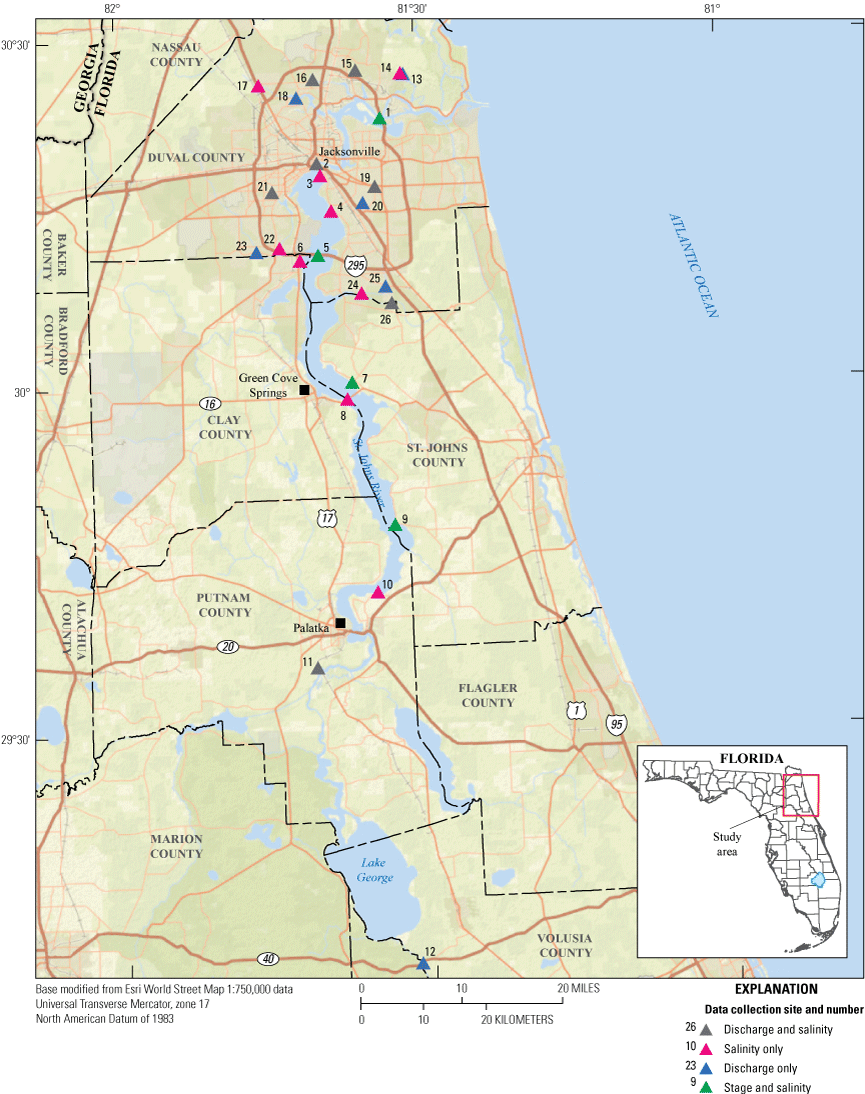
U.S. Geological Survey data collection sites on the St. Johns River and its tributaries. Map image is the intellectual property of Esri and is used herein under license. Copyright 2021 Esri and its licensors. All rights reserved.
Salinity models indicate that the harbor deepening may alter salinity in part of the study area, potentially causing (1) salinity stress in some wetlands and submerged aquatic vegetation and (2) changes in some fish and macroinvertebrate distributions (USACE, 2014). Surface-water monitoring, required by permit, includes the collection of water temperature, salinity, and (or) stage, velocity, and streamflow data for at least 6 months prior to dredging, continuously throughout dredging, and for 10 years following dredging (Florida Department of Environmental Protection, 2016). The U.S. Geological Survey (USGS), in cooperation with the USACE, is responsible for monitoring all parameters at the gage locations listed in the permit that were not already being monitored by other entities as of January 2016, the beginning of the initial data collection period (Florida Department of Environmental Protection, 2016). The streamflow and water-quality monitoring network was used to collect baseline data in the St. Johns River and its tributaries prior to dredging and can be used to discern changes, if any, during and after dredging.
This report provides an overview of the data collected from 26 surface-water discharge and water-quality sites along the St. Johns River and its tributaries (1) under predredging conditions and (2) during the third year of dredging and fifth year of the study, specifically from October 2019 to September 2020 (figs. 1 and 2). The report documents the data collection sites, methods used to compute discharge and salinity, and parameters monitored at each site. The first 4 years of the study are described in Ryan (2018, 2019, 2020a, b).
The data collected during this study are available from the USGS National Water Information System database (USGS, 2021).
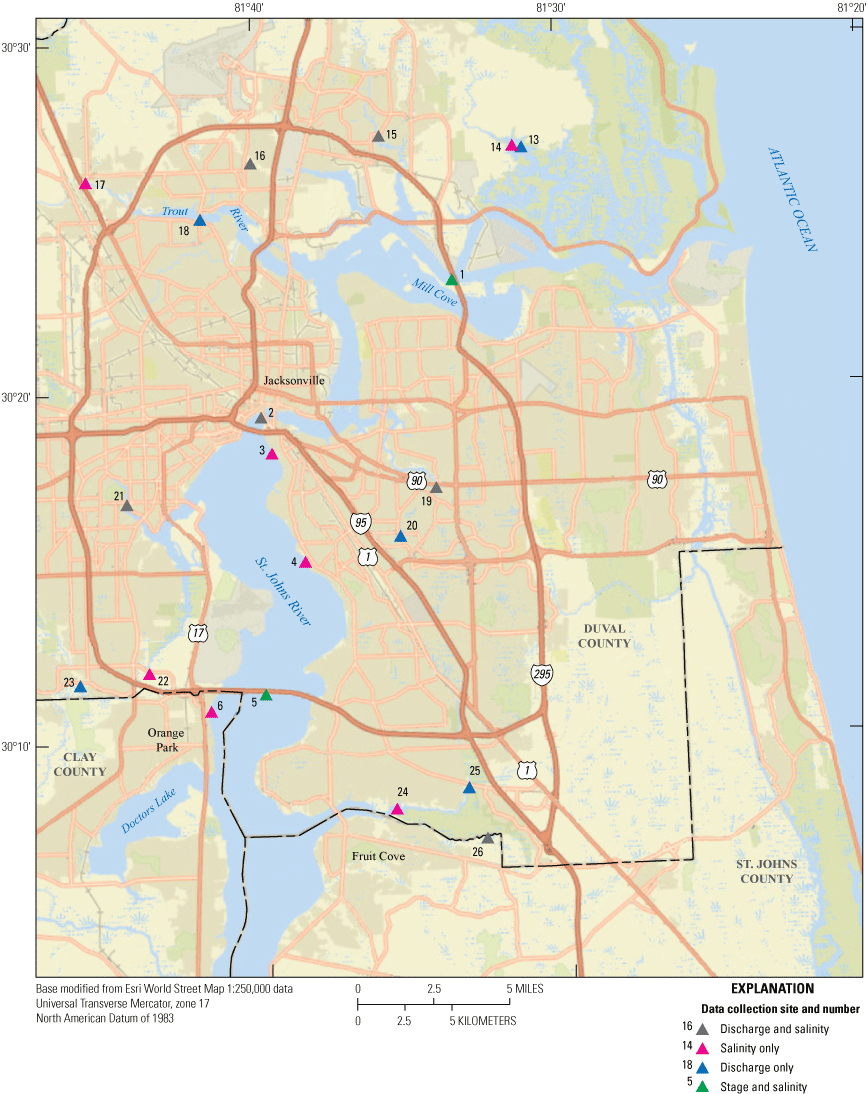
U.S. Geological Survey data collection sites in Clay, Duval, and St. Johns Counties, Florida. Map image is the intellectual property of Esri and is used herein under license. Copyright 2019 Esri and its licensors. All rights reserved.
Methods
The methods of data collection and processing, as well as the sites used for data collection, are described in the following sections. The descriptions of data collection sites are separated into those along the St. Johns River and those along its tributaries (table 1).
Table 1.
U.S. Geological Survey data collection sites on the main stem of the St. Johns River and its tributaries and parameters published during the 2020 water year.[USGS, U.S. Geological Survey; x, parameter measured; --, parameter not measured; NA, not applicable]
Methods of Data Collection and Processing
Stage data (gage height, in feet, referenced to the North American Vertical Datum of 1988) were collected at 15-minute intervals using various types of equipment, depending on location requirements, in accordance with USGS standards (Sauer and Turnipseed, 2010a). Discharge was routinely measured by using various types of equipment, depending on depth, velocity, and environmental conditions, in accordance with USGS standards (Sauer and Turnipseed, 2010b). Because of tidal and (or) wind effects, discharge was computed, in cubic feet per second, using the index-velocity method at most sites, in accordance with USGS techniques and methods (Levesque and Oberg, 2012). Discharge was computed using a stage-discharge relation at a few sites where tidal influence was not substantial (Rantz and others, 1982). Where applicable, discharge data were filtered by using the Godin low-pass filter to remove principal tidal frequencies from unit values (Godin, 1972). By convention, the USGS designates ebb (seaward) flow as positive flow and flood (landward) flow as negative flow. The residuals are not total freshwater flows, but instead, a combination of seaward freshwater flows from the watershed and landward saltwater flows from the marine environment, along with storm surges from hurricanes or tropical storms.
Water temperature, in degrees Celsius, and specific conductance, in microsiemens per centimeter at 25 degrees Celsius, were measured at intervals of 1 hour or less in accordance with USGS techniques and methods (Wagner and others, 2006). Water-quality meters were installed in situ at sites in freshwater environments. A pump and intake system was installed at sites in harsh saltwater environments to reduce fouling. This setup consisted of a meter housed inside a polyvinyl chloride chamber in a shelter. In this case, water was pumped into the chamber for 1–2 minutes before each measurement and drained from the chamber between measurements. The recording interval was reduced to one measurement per hour because of the power requirements for the pump setup. Because the chamber drains between measurements, water-quality parameters can be measured at multiple levels with one meter, if necessary. A rating table was used to convert specific conductance, in microsiemens per centimeter, to salinity, in parts per thousand (Wagner and others, 2006). Salinity was calculated for every site where water temperature and specific conductance were measured.
Missing discharge data can usually be attributed to equipment malfunction, either with the stage sensor or velocity meter (if the index-velocity method is used). For tidally filtered discharge calculation, the Godin low-pass filter requires 35 hours of continuous data before and after each data point (Godin, 1972). A data gap greater than 2 hours, therefore, results in a data gap of 3 days in the tidally filtered discharge record. For sites that include a pump setup, missing water-quality data are usually a consequence of power or pump failure, which prevents water from filling the chamber where the meter is housed. Biological fouling is a more common problem with meters installed in situ, where algal growth and crustaceans can affect the conductance measurement port or the temperature probe, both of which provide data used to calculate salinity. In either case, the affected values are not used, creating gaps in the final record.
Rainfall data for Duval, Clay, St. Johns, Putnam, and Volusia Counties in 2020 were obtained from the St. Johns River Water Management District (SJRWMD), which provides details about how average monthly rainfall data are compiled for counties in their district (SJRWMD, 2021). The period of record rainfall data to determine a long-term countywide average was compiled using National Oceanic and Atmospheric Administration (NOAA) rain gages in central and north Florida through 2009. Jacksonville Harbor and all monitoring sites included in this study are located within Duval County, except the St. Johns River sites at Astor in Volusia County, Dancy Point and Buffalo Bluff in Putnam County, Racy Point and Shands Bridge in St. Johns County, and above Buckman Bridge near the left bank in Clay County (fig. 1; table 1).
Quantile plots were created to show percentiles for annual discharge data collected at monitoring sites that have at least 10 years of record and a full contemporary year of data. The quantile plots group the annual peak discharges by water year. For this report, the 2020 water year includes data from October 1, 2019, to September 30, 2020. The resulting plots show how the 2020 water year discharge at a given station compares with that of previous water years. For discharges affected by tidal fluctuations, annual mean tidally filtered discharge was used to construct the plot.
Boxplots were created to provide a visual reference of median, interquartile range, and other useful statistics. These boxplots were constructed using all approved unit values of salinity and show salinity differences between water years.
Description of St. Johns River Main-Stem Sites
All sites on the main stem of the St. Johns River have substantive tidal influence, and therefore, the calculated discharge is tidally filtered. Only one change, the addition of salinity calculation at St. Johns River at Buffalo Bluff near Satsuma, was made to the monitoring network during this year of the study.
The farthest upstream discharge monitoring site on the St. Johns River is in Astor, Fla., at the State Road 40 Bridge (table 1; river mile 127). Approximately 37 mi downstream, discharge is also calculated for the St. Johns River at Buffalo Bluff (river mile 90). Tidally filtered discharge values have been computed since 1994 at both Astor and Buffalo Bluff. Water temperature and specific conductance are also measured at Buffalo Bluff at an approximate depth of 6 ft below the average high tide level. These parameters have been measured since the 2017 water year, so salinity was calculated using that data for comparison in this study. Another water-quality monitoring station along the St. Johns River is located downstream at Dancy Point (river mile 71), where water temperature and specific conductance are measured at an approximate depth of 11.5 ft below the average high-tide level. Stage, water temperature, and specific conductance are monitored farther downstream near the right bank of the St. Johns River at Racy Point (river mile 64). The water-quality parameters are measured at an approximate depth of 2.5 ft below the average high-tide level. Water temperature and specific conductance are collected near the channel of the St. Johns River at Shands Bridge (river mile 50). This location was historically monitored from April 1995 to September 2001 at multiple depths and from April 2008 to September 2009 at the middle depth. The meter was reinstalled in May 2018 at the middle-depth location of 10 ft below the average high-tide level. Just downstream near the right bank, stage, water temperature, and specific conductance are measured at an approximate depth of 8.5 ft below the average high-tide level at the St. Johns River below Shands Bridge (river mile 49).
A monitoring station is located near the left bank of the St. Johns River just upstream from Buckman Bridge. Water temperature and specific conductance are measured at an approximate depth of 4 ft below the average high-tide level at this station, St. Johns River above Buckman Bridge (river mile 35). A monitoring station at Buckman Bridge (river mile 34) near the main channel measures stage, water temperature, and specific conductance. The water-quality parameters are measured with separate pump setups and intakes at two different depths to measure possible stratification. One water-quality meter is used in the chamber and monitors both water properties at each depth. All water-quality parameters are monitored at approximate depths of 8 ft (top) and 16 ft (bottom) below the average high-tide level. Water-quality monitoring stations at Christopher Point (river mile 29) and Marco Lake (river mile 25) measure water temperature and specific conductance at an approximate depth of 4 ft below the average high-tide level for each location. These sites are characterized by relatively shallow water having an average depth of less than 6 ft and represent river conditions in seagrass beds near the shore.
The St. Johns River at Jacksonville, Fla., data collection station, located near downtown Jacksonville at Acosta Bridge (river mile 23), is the farthest downstream gage that calculates discharge. Stage and discharge were previously monitored before the dredging study began, but water temperature and specific conductance data collection began in October 2015 at an approximate depth of 11 ft below the average high-tide level. The monitoring equipment was moved to the center of the channel in April 2018 because of fender construction, and the intake was installed at a new depth of 17 ft below the average high-tide level. Velocity and streamflow direction data collection were added in October 2017. Tidally filtered discharge values have been computed since 1996. A monitoring station at Dames Point Bridge in Jacksonville (river mile 10) measures stage, velocity, water temperature, and specific conductance; calculation of salinity began in October 2016. All water-quality data are collected at approximate depths of 15 ft (top) and 22 ft (bottom) below the average high-tide level by using one water-quality meter and pump setup with separate intakes, similar to those used at the station at Buckman Bridge to measure possible stratification. At Dames Point, the collection of stage data began in October 2017, and the collection of velocity and streamflow direction data began in May 2018.
Description of Tributary Sites
No changes to the tributary monitoring network occurred during this year of the study. A monitoring station on Julington Creek at Old St. Augustine Road calculates discharge 6.7 mi upstream from the confluence of Julington Creek and the St. Johns River (table 1). A nearby water-quality monitoring station measures water temperature and specific conductance at an approximate depth of 3.5 ft below the average high-tide level and is located approximately 3 mi downstream from Old St. Augustine Road on Julington Creek at Hood Landing.
Durbin Creek is monitored for stage, discharge, water temperature, specific conductance, and salinity 3.5 mi upstream from the confluence with Julington Creek and 6.8 mi upstream from the confluence with the St. Johns River. The water-quality parameters are measured at an approximate depth of 3 ft below the average high-tide level. These locations are all tidally influenced, but large amounts of rainfall, resulting in increased discharge, can obscure the tidal signal.
Ortega River is monitored for stage and discharge at Argyle Forest Boulevard (Kirwin Road), 11 mi upstream from the confluence of the Ortega and St. Johns Rivers. Discharge has been computed intermittently at this location since 2002, and a stage-discharge rating was used for discharge computation during the study period, as no tidal influence is apparent in the stage data. A water-quality monitoring station that measures water temperature and specific conductance at an approximate depth of 6.5 ft below the average high-tide level is located at the bridge on Collins Road approximately 3 mi downstream from Kirwin Road at the Ortega River. Tidal influence is evident in the salinity data during times of low flow or increased stage in the St. Johns River.
The monitoring station on Cedar River measures stage, water temperature, and specific conductance at San Juan Avenue, 1.5 mi upstream from the confluence of the Cedar and St. Johns Rivers. The water-quality parameters are monitored at an approximate depth of 6 ft below the average high-tide level. Historical, tidally filtered discharge values have been computed intermittently since 2002. Wind, tide, and rainfall all substantively affect flow and salinity at Cedar River, and vertically stratified, bidirectional flow is commonly measured when strong winds occur opposite the direction of flow.
The station at Pottsburg Creek near South Jacksonville measures stage and is 7.3 mi upstream from the confluence of Pottsburg Creek and the St. Johns River. A stage-discharge rating was used for discharge computation during the study period. The data indicate tidal influence when stage is very low in the creek and elevated in the St. Johns River, but discharge measurements confirm the validity of the stage-discharge relation. Pottsburg Creek is monitored for stage, discharge, water temperature, specific conductance, and salinity at U.S. 90, 5.2 mi upstream from the confluence of Pottsburg Creek and the St. Johns River. The water-quality parameters are monitored at an approximate depth of 4 ft below the average high-tide level. This location has a more pronounced tidal signal than the upstream location on Pottsburg Creek, and discharge and salinity are affected primarily by rainfall and elevated stage in the river.
The monitoring station for Trout River calculates discharge at Lem Turner Road, 5 mi upstream from the confluence of the Trout and St. Johns Rivers. Water temperature and specific conductance are measured 9.3 mi upstream from the confluence at an approximate depth of 6 ft below the average high-tide level. Broward River is monitored for stage, discharge, water temperature, specific conductance, and salinity near Biscayne Boulevard, 6.3 mi upstream from its confluence with the St. Johns River. The water-quality parameters are monitored at an approximate depth of 4.5 ft below the average high-tide level. Discharge and salinity at these stations have a pronounced tidal signal, even when stage is elevated.
Dunn Creek is monitored for stage, discharge, water temperature, specific conductance, and salinity at Dunn Creek Road, 5.3 mi upstream from the confluence of Dunn Creek and the St. Johns River. The monitoring station for Clapboard Creek calculates discharge near Sheffield Road, 4.5 mi upstream from the confluence of Clapboard Creek and the St. Johns River. Water temperature and specific conductance are measured at a location 0.5 mi upstream. The water-quality parameters are monitored at approximate depths of 5.5 and 6.5 ft below the average high-tide level. Discharge and salinity fluctuations at these stations are dependent on rainfall in the relatively small drainage area and on wind effects from the St. Johns River, owing to the proximity of the sites to the river and Atlantic Ocean.
Results
Discharge and salinity varied widely during the 2020 water year because of the large study area and diversity of sites. As expected, salinities were lowest at the tributary sites farthest from the ocean and highest during periods of low flow in the St. Johns River. Discharge also increased at both the tributary and main-stem sites during periods of increased rainfall.
Rainfall, daily discharge, and salinity plots for the 2020 water year (October 2019–September 2020) are presented in the following sections where applicable. A year refers to a water year in these sections unless otherwise noted. Daily discharge is tidally filtered at sites where substantive tidal fluctuations occur. Salinity values are not filtered and include daily maximum, minimum, and mean values. Instantaneous values can be accessed via the USGS National Water Information System database (USGS, 2021). Annual mean discharges are calculated only for sites having at least an entire year of discharge record. The annual mean is not calculated for partial years of record when stations were installed. Quantile plots are only available for sites with a minimum of 10 years of streamflow record.
Rainfall
Duval County rainfall for the 2020 water year (October 2019–September 2020) was 5.6 inches (in.) above the long-term average (SJRWMD, 2021). Monthly total rainfall ranged from 2.5 in. below average in January to 3.8 in. above average in June (fig. 3). Duval County had the second-highest annual rainfall compared to the cumulative long-term average of the five counties included in this study (SJRWMD, 2021). Annual rainfall averaged 1.3 in. above and 3.4 in. below average for Clay and St. Johns Counties, respectively, and annual rainfall was less for both counties than for Duval County (SJRWMD, 2021). The highest monthly rainfall total for Clay County occurred in June and was 2.7 in. above average, and the highest positive monthly departure for St. Johns County, 1.9 in. above average, occurred in December. The lowest monthly rainfall totals for the two counties occurred in March and were 2.5 below average for Clay County and 3.2 in. below average for St. Johns County (figs. 4 and 5). Of the five counties compared for this study, the two northernmost counties, Duval County and Clay County, ranked second and third for rainfall totals in the 2020 water year.
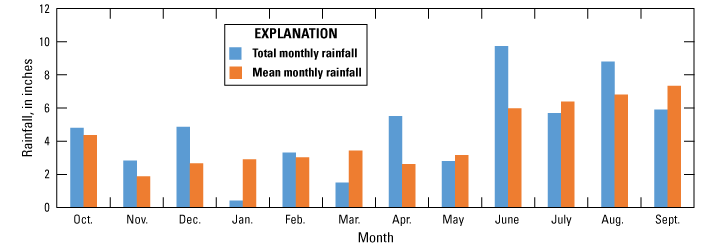
Graph showing 2020 water year monthly rainfall and mean monthly rainfall for Duval County (St. Johns River Water Management District [SJRWMD], 2021).
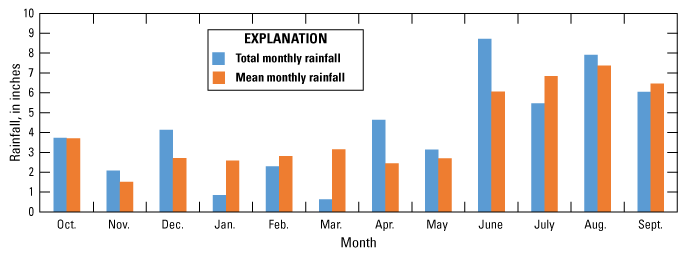
Graph showing 2020 water year monthly rainfall and mean monthly rainfall for Clay County (St. Johns River Water Management District [SJRWMD], 2021).
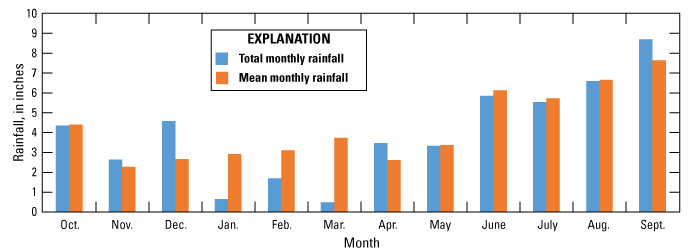
Graph showing 2020 water year monthly rainfall and mean monthly rainfall for St. Johns County (St. Johns River Water Management District [SJRWMD], 2021).
Rainfall totals for Putnam County and Volusia County were 3.4 in. below and 9.1 in. above their average yearly totals, respectively (SJRWMD, 2021). Rainfall for Putnam County ranged from 2.0 in. above average in December to 2.5 in. below average in March (fig. 6). Rainfall for Volusia County ranged from 4.3 in. above average in October to 3.0 in. below average in March (fig. 7). Rainfall for each of the five counties was below the average monthly total from January to March except Duval County, which was slightly above average in February.
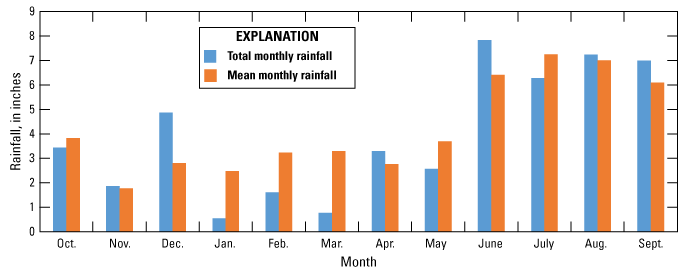
Graph showing 2020 water year monthly rainfall and mean monthly rainfall for Putnam County (St. Johns River Water Management District [SJRWMD], 2021).
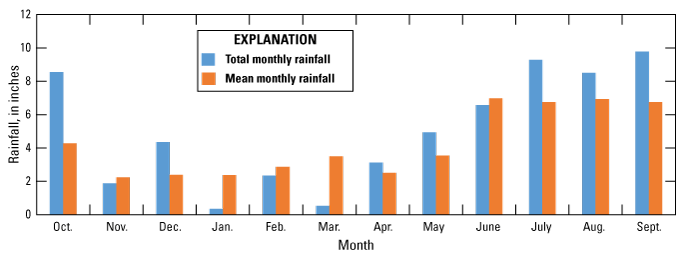
Graph showing 2020 water year monthly rainfall and mean monthly rainfall for Volusia County (St. Johns River Water Management District [SJRWMD], 2021).
Main-Stem Sites
The parameters collected on the main stem of the St. Johns River are affected by many factors, including tidal influence, rainfall, and wind. Heavy rainfall typically increases discharge and decreases salinity, and the tidal influence introduces more fluctuations than a nontidal system. Strong easterly winds can increase salinity in the St. Johns River as ocean water with higher salinity is pushed upstream and can lower or even produce negative discharge for multiple days. When the wind calms or changes direction, discharge typically increases sharply as this ocean water and other tributary inflows exit the river.
St. Johns River at Astor, Florida—Daily tidally filtered discharge at Astor ranged from −3,720 to 9,800 cubic feet per second (ft3/s) during the 2020 water year, with an annual mean of 2,900 ft3/s (fig. 8). Tidally filtered discharge was estimated for 5 days in December, 12 days in June, and 5 days in September. A comparison of historical annual mean tidally filtered flows indicated that 2020 streamflow was at the 56th percentile of the 26 years of record; the median tidally filtered annual mean flow for the period of record is 2,820 ft3/s (fig. 9). The annual peak discharge occurred in September after 3 consecutive months of above-average rainfall in Volusia County (fig. 7).
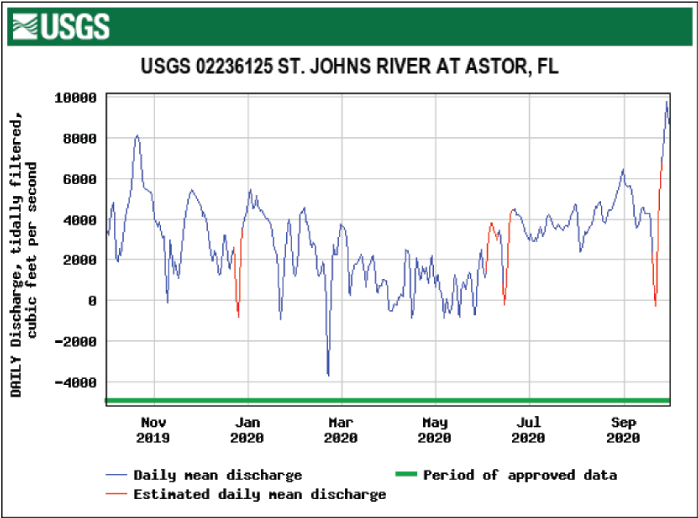
Daily mean tidally filtered discharge for St. Johns River at Astor, Florida.
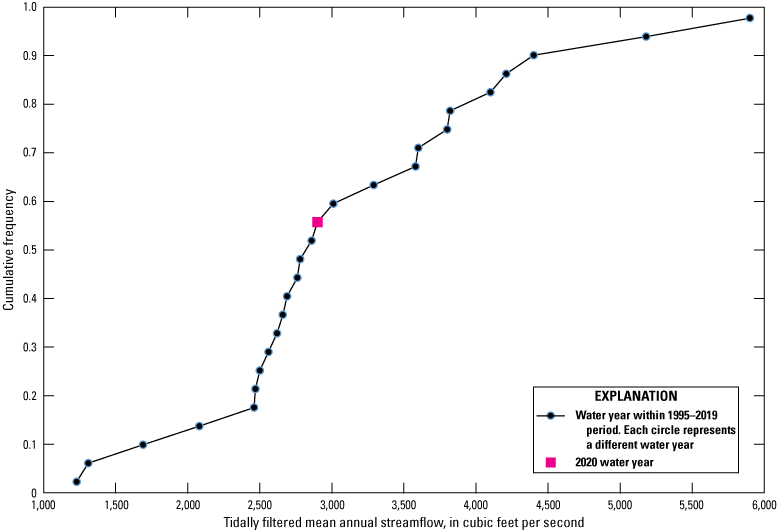
Annual mean tidally filtered streamflow data for St. Johns River at Astor, Florida.
St. Johns River at Buffalo Bluff near Satsuma, Florida—Daily tidally filtered discharge at Buffalo Bluff ranged from −14,900 to 18,100 ft3/s during the 2020 water year, with an annual mean of 4,780 ft3/s (fig. 10). Salinity ranged from 0.3 to 0.7 parts per thousand (ppt) over this same period, with a median and mean of 0.5 ppt (fig. 11). There were 35 days of missing salinity data from June to July and 5 days of missing discharge data in August caused by equipment malfunction. A comparison of historical annual mean tidally filtered flows indicated that 2020 streamflow was at the 65th percentile of the 27 years of record; the median tidally filtered flow for the period of record is 4,480 ft3/s (fig. 12). The lowest tidally filtered discharge for the 2020 water year occurred in late February during a period of below-average rainfall in Putnam County (fig. 6). The annual mean and median salinity are within 0.2 ppt for the 4 years salinity was calculated in the study (fig. 13).
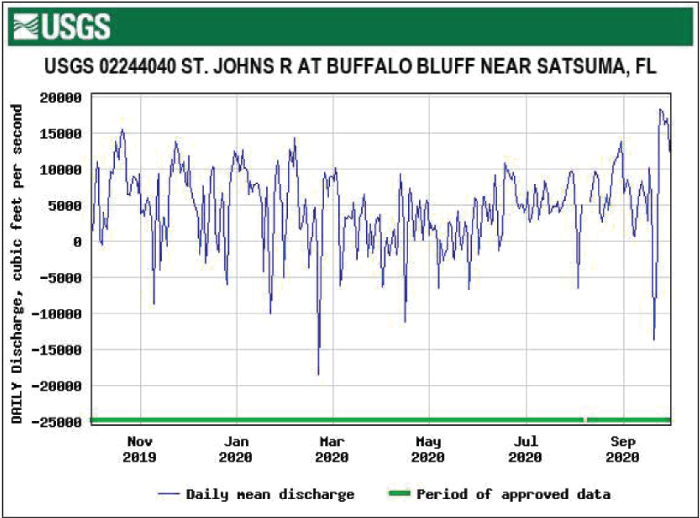
Daily mean tidally filtered discharge for St. Johns River at Buffalo Bluff near Satsuma, Florida.
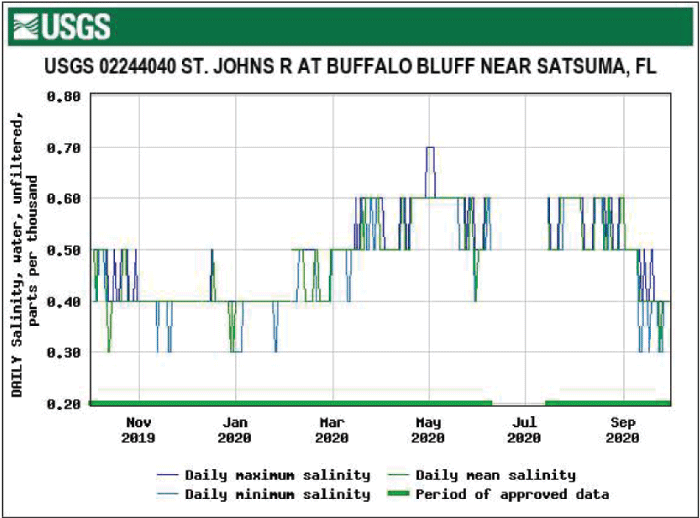
Daily maximum, minimum, and mean salinity for St. Johns River at Buffalo Bluff near Satsuma, Florida.
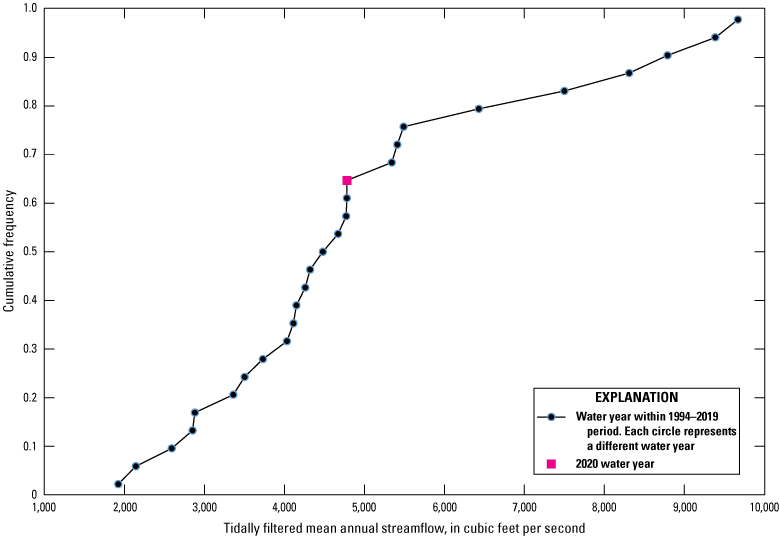
Annual mean tidally filtered streamflow data for St. Johns River at Buffalo Bluff near Satsuma, Florida.
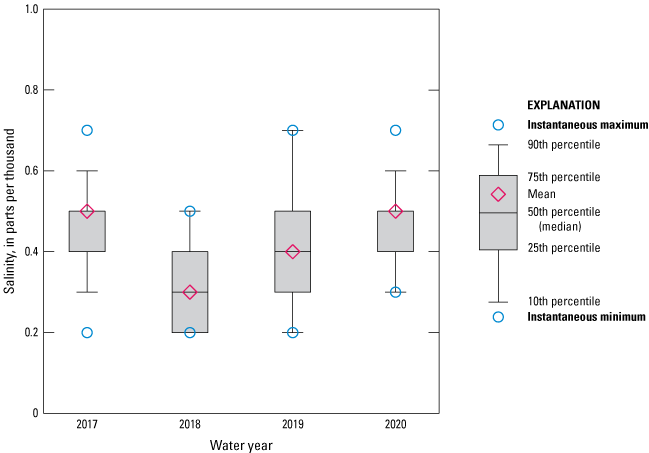
Salinity data for St. Johns River at Buffalo Bluff near Satsuma, Florida.
St. Johns River at Dancy Point near Spuds, Florida—Salinity on the St. Johns River at Dancy Point ranged from 0.3 to 0.6 ppt during the 2020 water year, with a median and mean of 0.5 ppt (fig. 14). The salinity data show fluctuations caused by tidal effects and rainfall, and a gradual increase from March to May. The annual mean and median salinity are within 0.2 ppt for the 4 years salinity was calculated in the study (fig. 15).
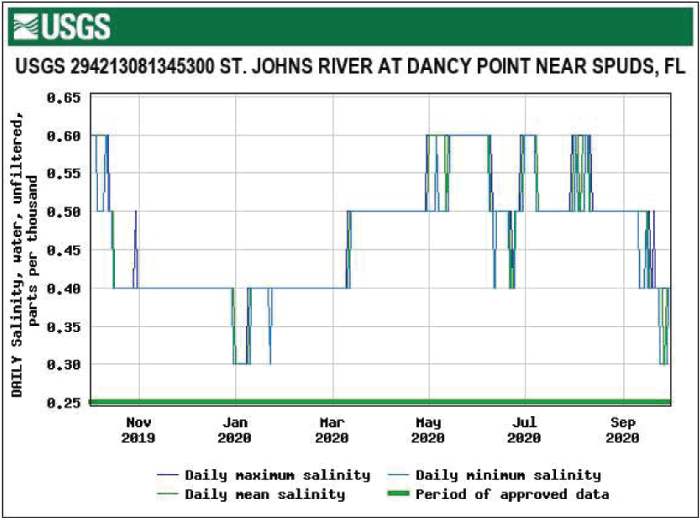
Daily maximum, minimum, and mean salinity for St. Johns River at Dancy Point near Spuds, Florida.
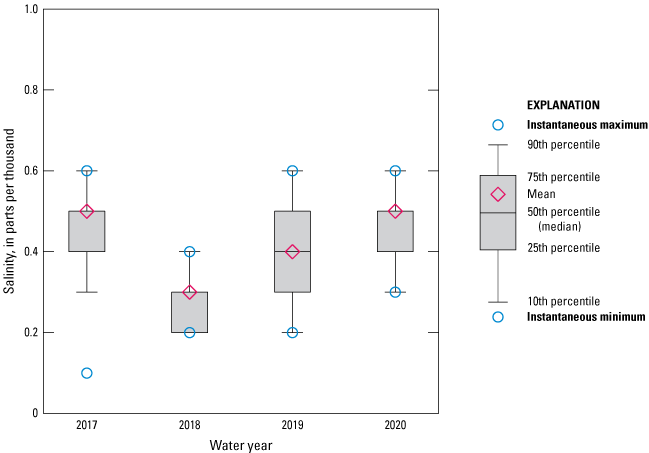
Salinity data for St. Johns River at Dancy Point near Spuds, Florida.
St. Johns River at Racy Point near Hastings, Florida—Salinity on the St. Johns River at Racy Point ranged from 0.3 to 0.6 ppt during the 2020 water year, with a median of 0.4 ppt and mean of 0.5 ppt (fig. 16). There were 4 days of missing salinity data each in April and May, 14 days in June, and 5 days in July caused by equipment malfunction. Like computed salinity at the Buffalo Bluff site, computed salinity at Racy Point gradually increased from March to May. The 2020 mean salinity was the highest by 0.1 ppt over the 3 years considered for this study (fig. 17).
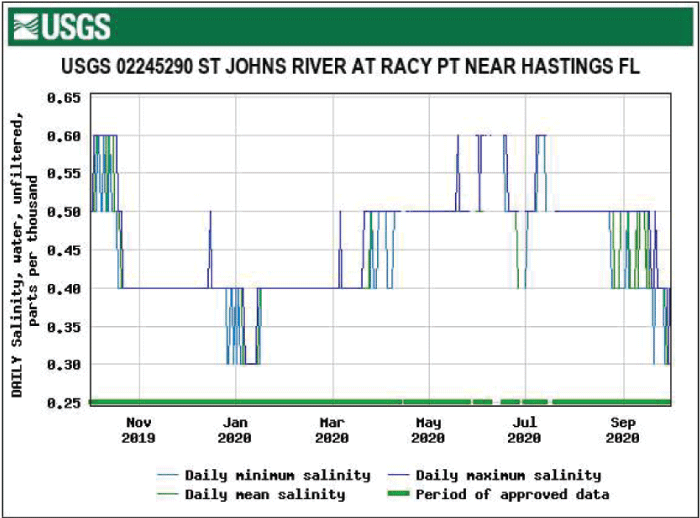
Daily maximum, minimum, and mean salinity for St. Johns River at Racy Point near Hastings, Florida.
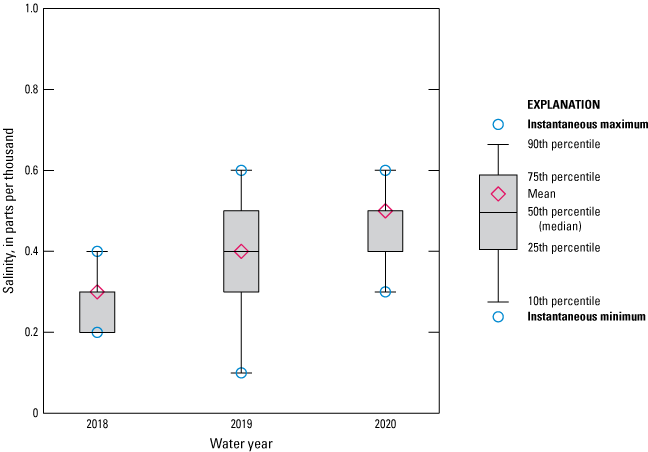
Salinity data for St. Johns River at Racy Point near Hastings, Florida.
St. Johns River Shands Bridge near Green Cove Springs, Florida—Salinity on the St. Johns River Shands Bridge ranged from 0.3 to 2.8 ppt during the 2020 water year, with a median and mean of 0.5 ppt (fig. 18). There were 44 days of missing salinity data from May to June and 3 days of missing salinity data in September, all caused by equipment malfunction. Salinity peaked in early April after below-average rainfall occurred in March in St. Johns County (fig. 5). A boxplot of salinity data shows a higher median, mean, and maximum for 2020 compared to 2018 and 2019 (fig. 19).
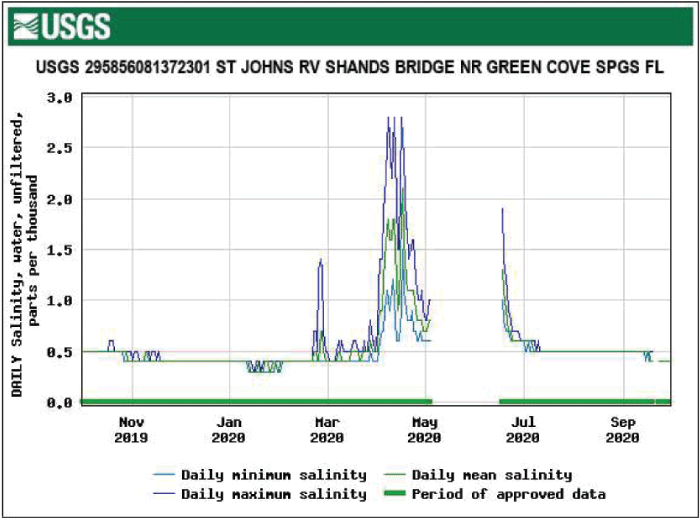
Daily maximum, minimum, and mean salinity for St. Johns River Shands Bridge near Green Cove Springs, Florida.
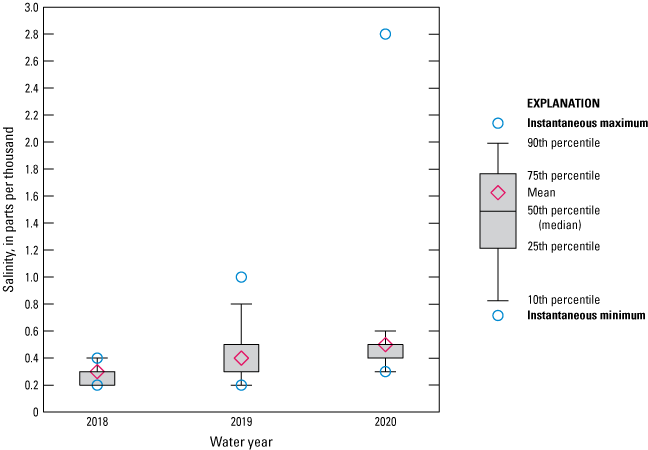
Salinity data for St. Johns River Shands Bridge near Green Cove Springs, Florida.
St. Johns River below Shands Bridge near Green Cove Springs, Florida—Salinity on the St. Johns River below Shands Bridge ranged from 0.3 to 4.5 ppt during the 2020 water year, with a median of 0.5 ppt and mean of 0.8 ppt (fig. 20). Daily salinity data were not computed for many days from October to January and for 10 days from June to July because of equipment malfunction. The maximum salinity of 4.5 ppt is higher than the maximum of 2.8 ppt at the nearby station at Shands Bridge, most likely because the monitoring equipment is located near the right bank instead of near the center of the river channel. In addition, salinity was not computed at the Shands Bridge site on the day the peak occurred below Shands Bridge. The 2020 median salinity is the highest among those computed for the 4 years of the study, and the 2020 mean salinity ranked second (fig. 21).
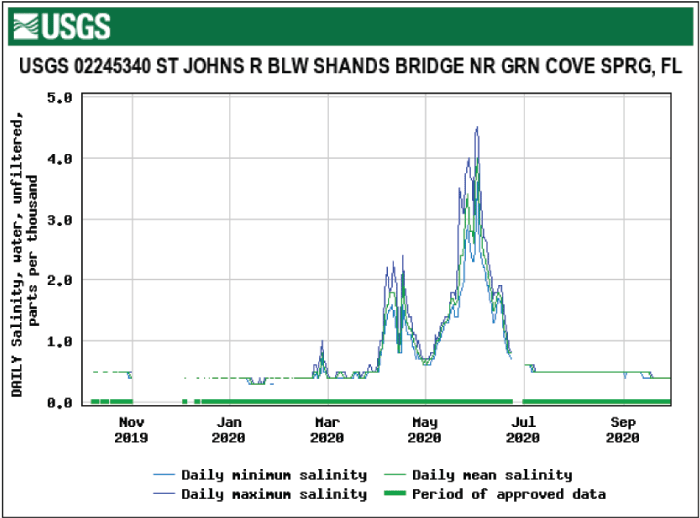
Daily maximum, minimum, and mean salinity for St. Johns River below Shands Bridge near Green Cove Springs, Florida.
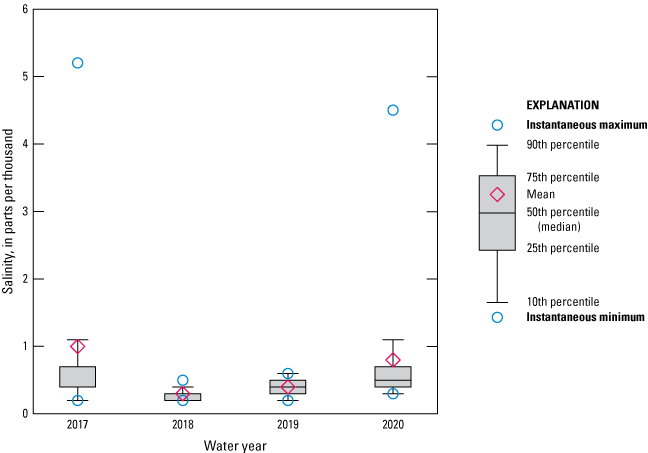
Salinity data for St. Johns River below Shands Bridge near Green Cove Springs, Florida.
St. Johns River above Buckman Bridge at Jacksonville, Florida—Salinity on the St. Johns River above Buckman Bridge ranged from 0.4 to 12 ppt during the 2020 water year, with a median of 1.5 ppt and mean of 2.6 ppt (fig. 22). Daily maximum salinity peaked above 10 ppt in February, April, and May before above-average rainfall in Clay County in June lowered the salinity (fig. 4). The median and mean salinity for 2020 were both the highest among those computed for the 3 years of the study, although 2018 has incomplete record because the monitoring station was installed that year (fig. 23).
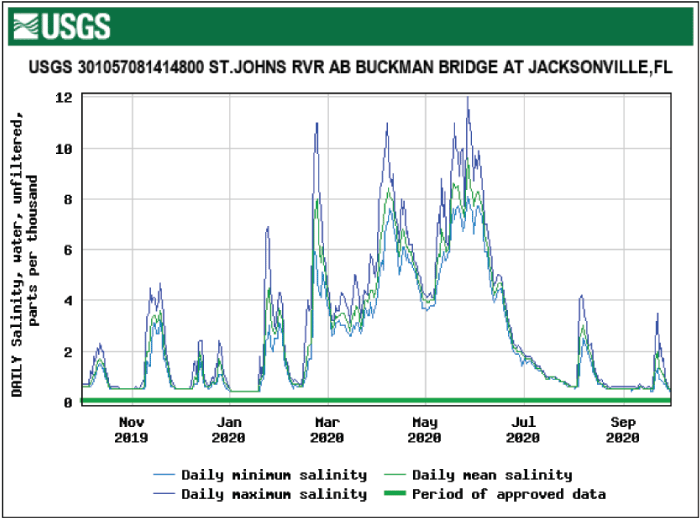
Daily maximum, minimum, and mean salinity for St. Johns River above Buckman Bridge at Jacksonville, Florida.
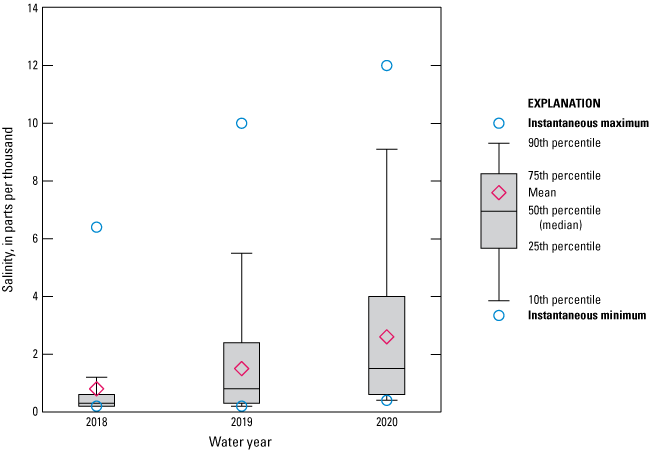
Salinity data for St. Johns River above Buckman Bridge at Jacksonville, Florida.
St. Johns River Buckman Bridge at Jacksonville, Florida—Salinity on the St. Johns River at Buckman Bridge ranged from 0.3 to 16 ppt for the top location during the 2020 water year, with a median of 1.6 ppt and mean of 2.9 ppt, and from 0.3 to 18 ppt for the bottom location, with a median of 1.8 ppt and mean of 3.2 ppt (figs. 24 and 25). The monitoring station did not record water-quality data at either location for 28 days from February to March and 6 days in May because of equipment malfunction. Salinity during the year was generally lower at the top location relative to the bottom. Salinity at both locations increased gradually from March through May before higher rainfall in June in Duval and Clay Counties lowered the salinity (figs. 3 and 4). The 2020 median and mean salinity at both the top and bottom locations ranked second among those computed for the 4 years of the study (figs. 26 and 27).
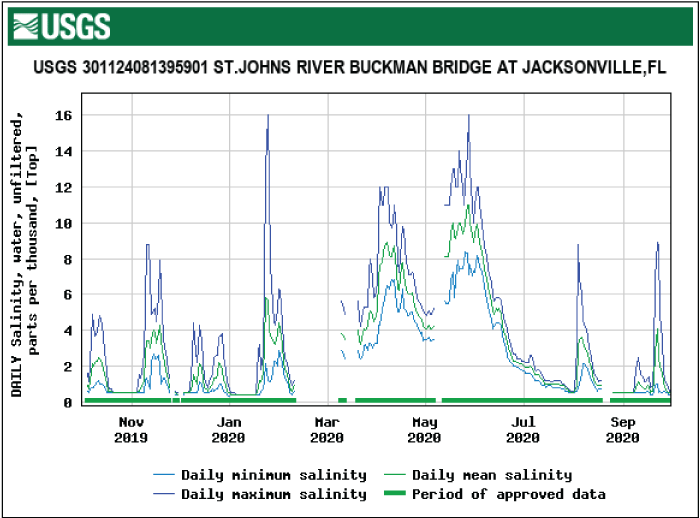
Daily maximum, minimum, and mean salinity for top location of St. Johns River Buckman Bridge at Jacksonville, Florida.
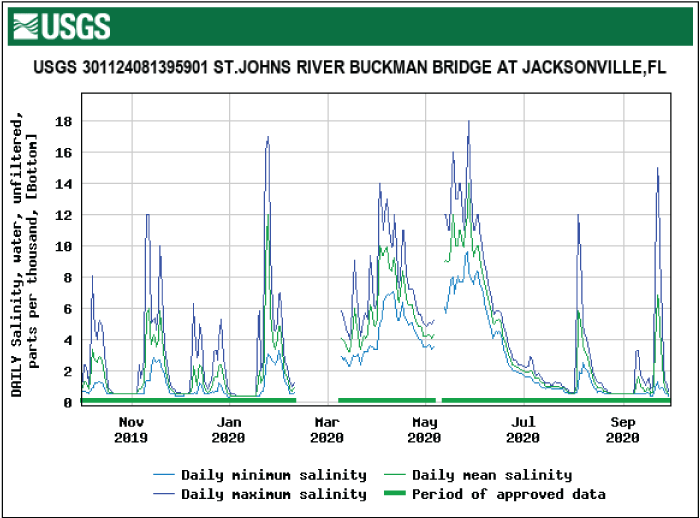
Daily maximum, minimum, and mean salinity for bottom location of St. Johns River Buckman Bridge at Jacksonville, Florida.
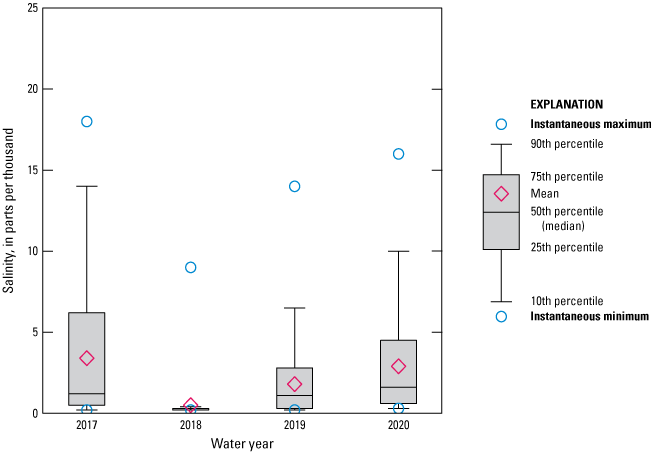
Salinity data for top location of St. Johns River Buckman Bridge at Jacksonville, Florida.
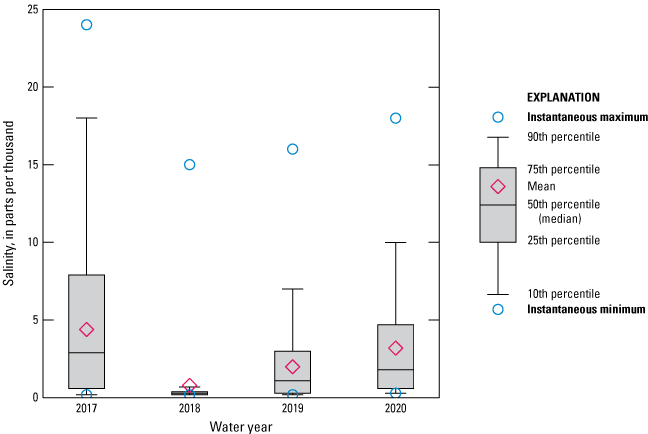
Salinity data for bottom location of St. Johns River Buckman Bridge at Jacksonville, Florida.
St. Johns River at Christopher Point near Jacksonville, Florida—Salinity at Christopher Point ranged from 0.4 to 24 ppt during the 2020 water year, with a median of 2.9 ppt and mean of 4.2 ppt (fig. 28). The annual maximum salinity occurred in February after very low rainfall in Duval County in January (fig. 3). The 2020 maximum salinity ranked second among those computed for the 5 years of the study, and the median and mean salinity both ranked third (fig. 29).
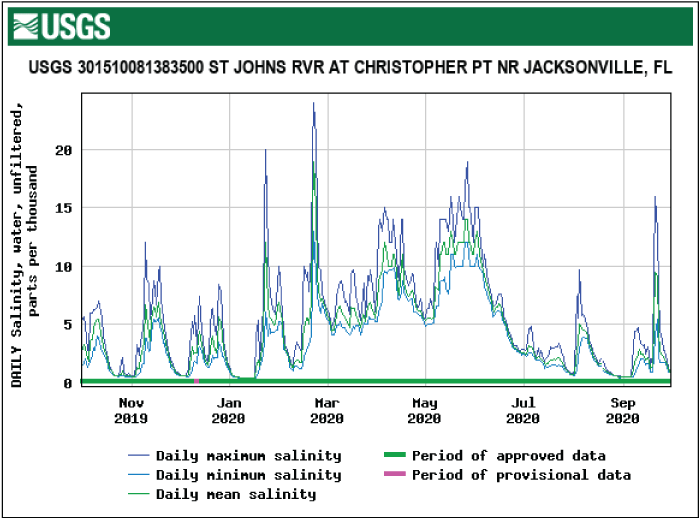
Daily maximum, minimum, and mean salinity for St. Johns River at Christopher Point near Jacksonville, Florida.
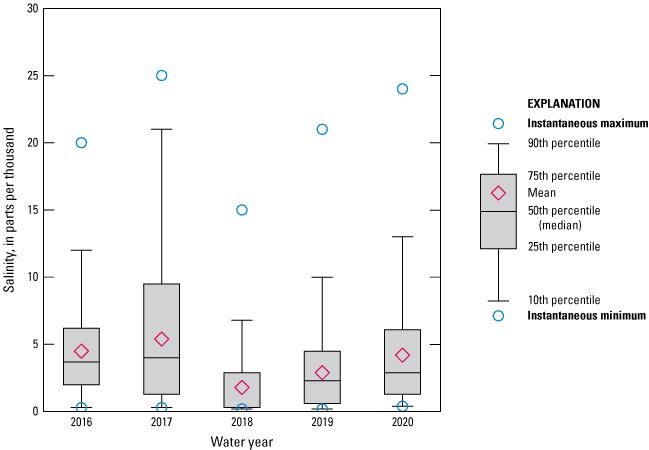
Salinity data for St. Johns River at Christopher Point near Jacksonville, Florida.
St. Johns River below Marco Lake at Jacksonville, Florida—Salinity at Marco Lake ranged from 0.4 to 28 ppt during the 2020 water year, with a median of 6.2 ppt and mean of 7.0 ppt (fig. 30). Salinity was not computed for 6 days in July because of equipment malfunction. As at the Christopher Point site, the annual maximum salinity at this site occurred in February after very low rainfall in Duval County in January (fig. 3). The 2020 median salinity ranked third among those computed for the 5 years of the study, and the mean and maximum salinity ranked second (fig. 31).
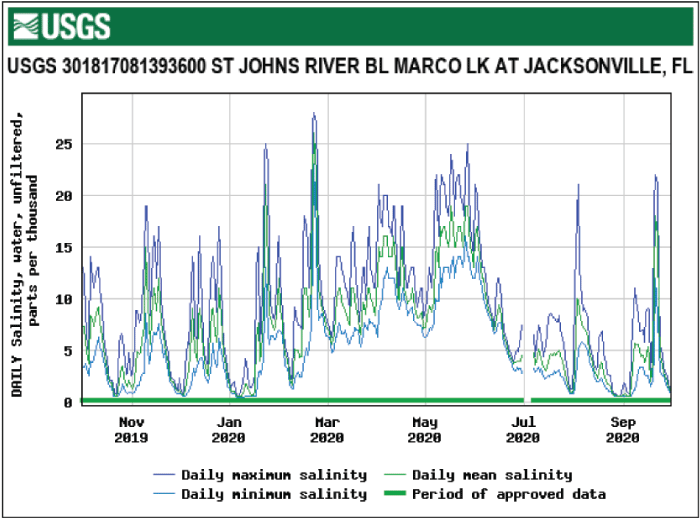
Daily maximum, minimum, and mean salinity for St. Johns River below Marco Lake at Jacksonville, Florida.
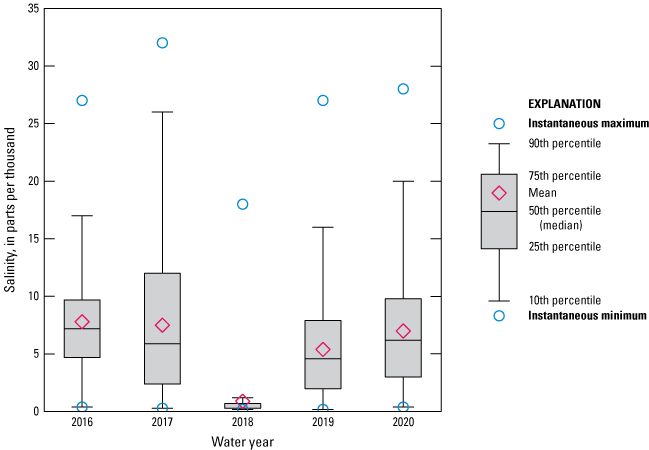
Salinity data for St. Johns River below Marco Lake at Jacksonville, Florida.
St. Johns River at Jacksonville, Florida—Daily tidally filtered discharge at the St. Johns River at Jacksonville site ranged from −39,900 to 38,300 ft3/s during the 2020 water year, with an annual mean of 5,830 ft3/s (fig. 32). Salinity ranged from 0.4 to 28 ppt over this same period, with a median of 7.6 ppt and mean of 8.4 ppt (fig. 33). Salinity exceeded 25 ppt three times during the water year in January, February, and May. Salinity was not computed for 3 days in February because of equipment malfunction. A comparison of historical annual mean tidally filtered flows indicated that the 2020 streamflow was at the 52d percentile of the 24 years of record; the median tidally filtered flow for the period of record is 5,660 ft3/s (fig. 34). Annual mean tidally filtered streamflow record was used from 1997 onward because of data collection gaps in the historical data prior to 1997. The 2020 mean and median salinity ranked the highest among those computed for the 5 years of the study, but the maximum salinity ranked fourth (fig. 35).
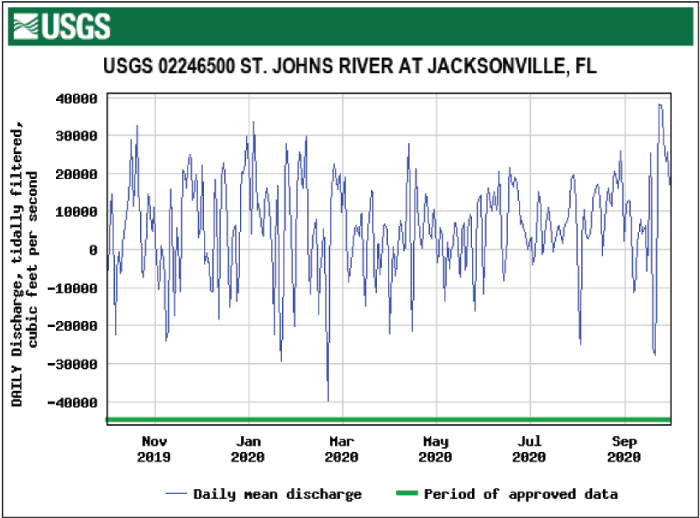
Daily mean tidally filtered discharge for St. Johns River at Jacksonville, Florida.
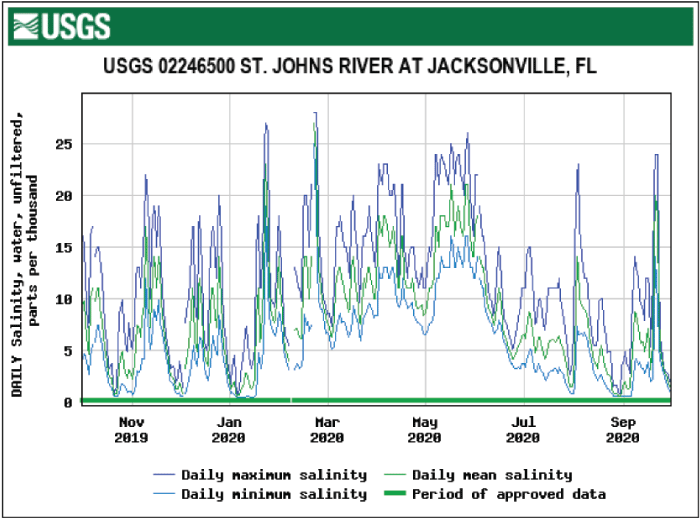
Daily maximum, minimum, and mean salinity for St. Johns River at Jacksonville, Florida.
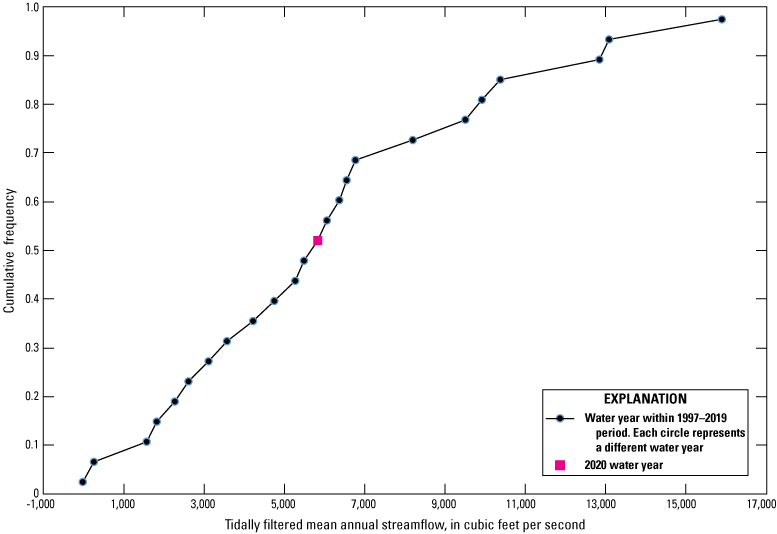
Annual mean tidally filtered streamflow data for St. Johns River at Jacksonville, Florida.
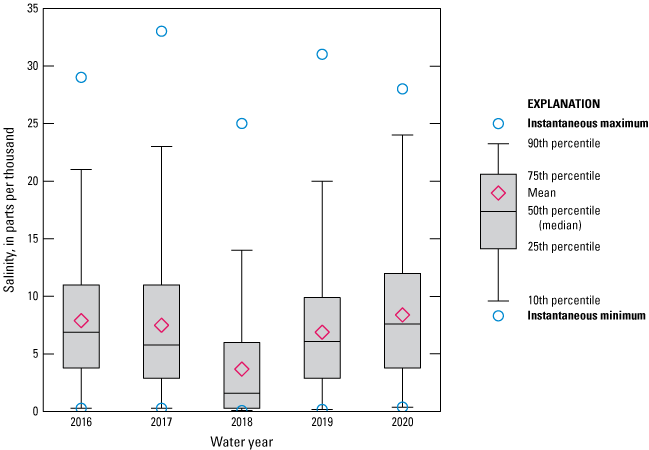
Salinity data for St. Johns River at Jacksonville, Florida.
St. Johns River Dames Point Bridge at Jacksonville, Florida—Salinity on the St. Johns River at Dames Point Bridge ranged from 3.7 to 34 ppt for the top location during the 2020 water year, with a median of 23 ppt and mean of 22 ppt, and from 4.4 to 34 ppt for the bottom location, with a median of 24 ppt and mean of 23 ppt (figs. 36 and 37). Salinity was not calculated for 28 days in February and March at both locations and for 6 days at the top location in September because of equipment malfunction. Salinity during the year was generally lower at the top location relative to the bottom and fluctuated weekly at both locations because of upstream conditions. The 2020 mean and median salinity at the top location ranked the highest among those calculated for the 4 years of the study, but the mean tied that of 2017 (fig. 38). For the bottom location, the 2020 median salinity ranked the highest among those calculated for the 4 years of the study, and the mean ranked second (fig. 39).
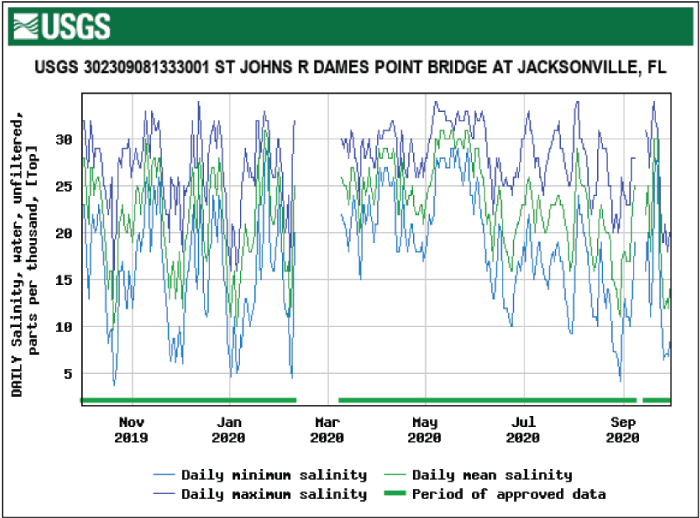
Daily maximum, minimum, and mean salinity for top location of St. Johns River Dames Point Bridge at Jacksonville, Florida.
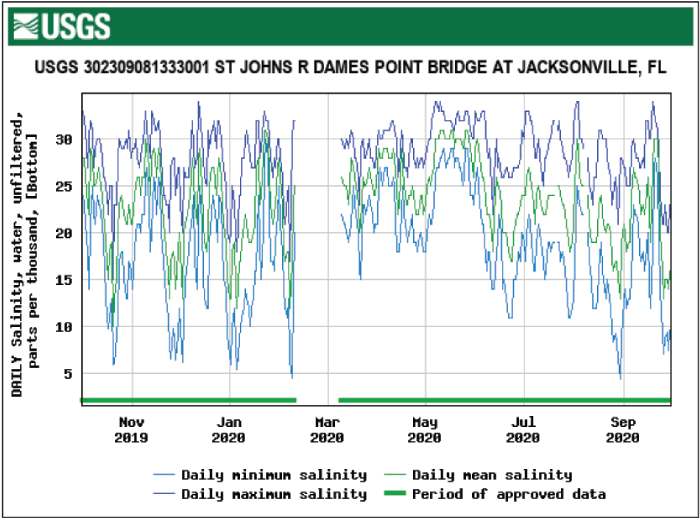
Daily maximum, minimum, and mean salinity for bottom location of St. Johns River at Dames Point Bridge at Jacksonville, Florida.
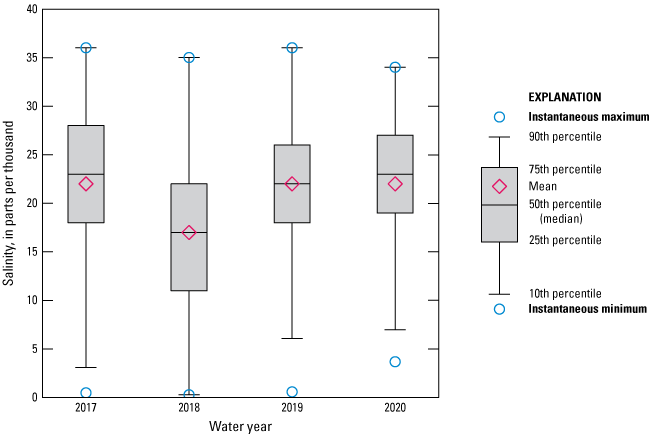
Salinity data for top location of St. Johns River at Dames Point Bridge at Jacksonville, Florida.
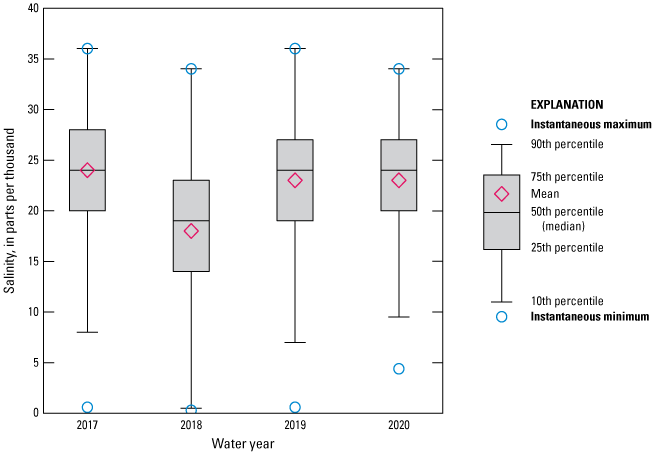
Salinity data for bottom location of St. Johns River at Dames Point Bridge at Jacksonville, Florida.
Tributary Sites
The parameters collected on the tributaries of the St. Johns River are mainly affected by rainfall and, at most sites, by tidal fluctuations. Heavy rainfall typically increases discharge and decreases salinity, and the tidal influence introduces more daily fluctuation at tidal sites than at nontidal sites. Like the main stem, tributaries of the St. Johns River are also affected by strong easterly winds. Because of their distance from the ocean, tributary sites and main-stem sites farther upstream require prolonged or extremely strong winds, such as those from a hurricane, to experience increased salinity.
Julington Creek at Old St. Augustine Road near Bayard, Florida—Daily tidally filtered discharge at Julington Creek ranged from −30.7 to 368 ft3/s during the 2020 water year, with an annual mean flow of 28.7 ft3/s (fig. 40). The highest discharge peak in 2020 occurred in June as a result of above-average rainfall in Duval County (fig. 3). Discharge was not calculated for 5 days in July because of equipment malfunction.
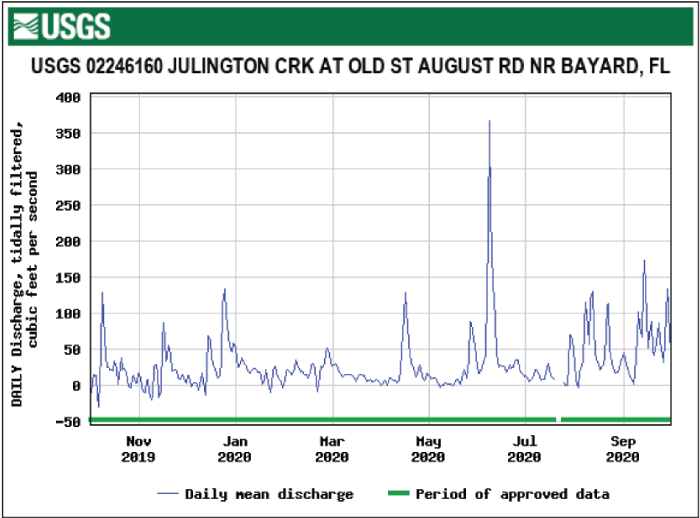
Daily mean tidally filtered discharge for Julington Creek at Old St. Augustine Road near Bayard, Florida.
Julington Creek at Hood Landing near Bayard, Florida—Salinity at Julington Creek at Hood Landing ranged from 0.1 to 3.5 ppt during the 2020 water year, with a median of 0.3 ppt and mean of 0.6 ppt (fig. 41). The daily maximum salinity exceeded 1.0 ppt during low flows from March to June and decreased after the discharge peak in June (fig. 40). The 2020 median salinity ranked the highest among those computed for the 5 years of the study, and the mean salinity ranked second (fig. 42).
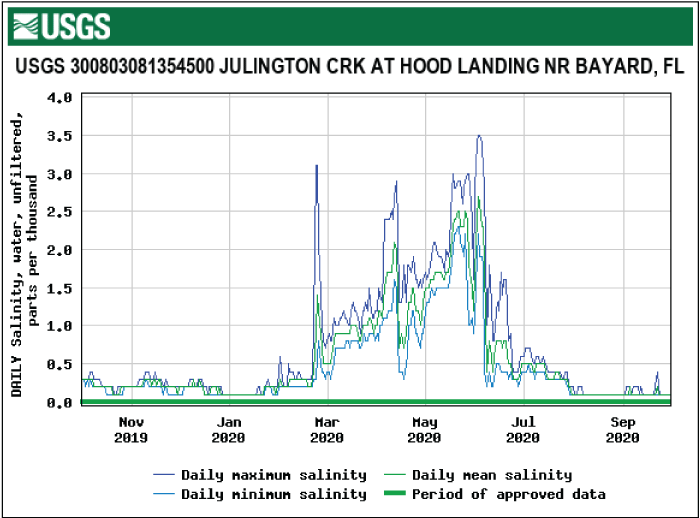
Daily maximum, minimum, and mean salinity for Julington Creek at Hood Landing near Bayard, Florida.
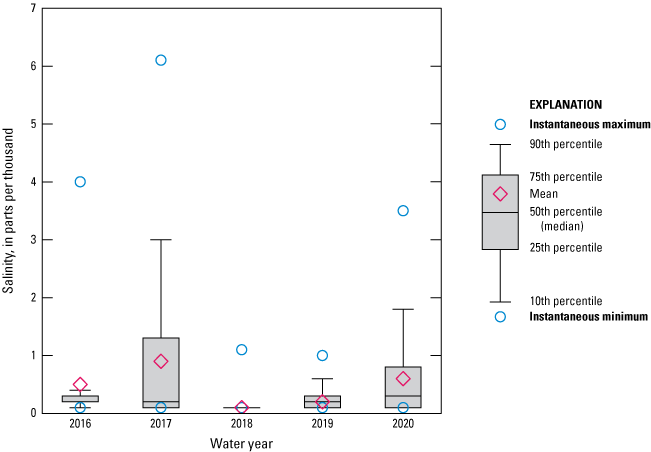
Salinity data for Julington Creek at Hood Landing near Bayard, Florida.
Durbin Creek near Fruit Cove, Florida—Daily tidally filtered discharge at Durbin Creek ranged from −39.5 to 270 ft3/s during the 2020 water year, with an annual mean of 50.8 ft3/s (fig. 43). The highest discharge peak in 2020 occurred in September as a result of above-average rainfall in St. Johns County (fig. 5). Salinity ranged from 0.1 to 1.5 ppt, with a median and mean of 0.1 ppt (fig. 44). The boxplot for Durbin Creek salinity data in 2020 shows the same mean and median for all 5 years of the study; the maximum salinity ranked second among those computed for the 5 years of the study (fig. 45). The boxplot includes no whiskers because of the low and steady salinities of freshwater flows through the creek.
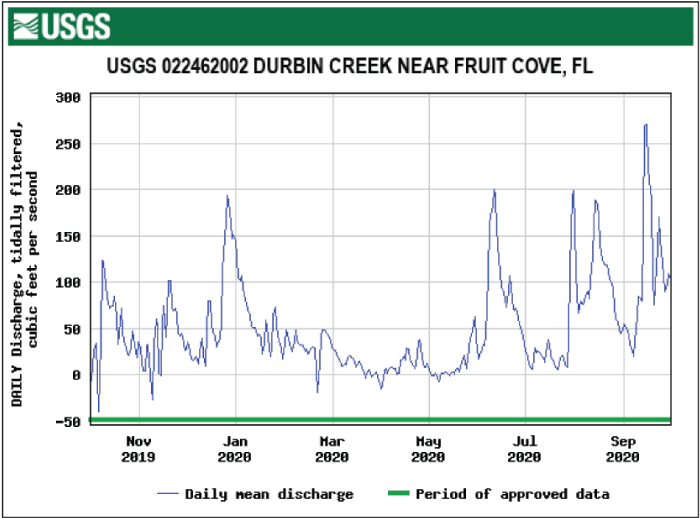
Daily mean tidally filtered discharge for Durbin Creek near Fruit Cove, Florida.
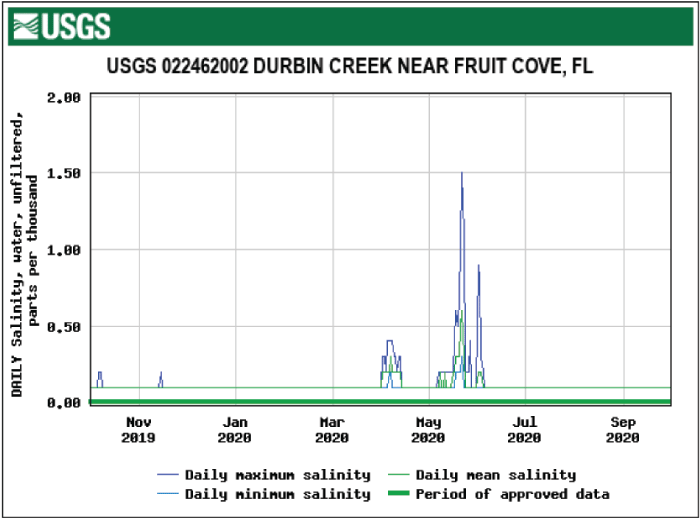
Daily maximum, minimum, and mean salinity for Durbin Creek near Fruit Cove, Florida.

Salinity data for Durbin Creek near Fruit Cove, Florida.
Ortega River at Kirwin Road near Jacksonville, Florida—Daily discharge for Ortega River ranged from 3.53 to 1,180 ft3/s during the 2020 water year, with an annual mean of 58.1 ft3/s (fig. 46). Like Julington Creek, Ortega River had the largest discharge peak in June. The peak streamflow for the period of record ranked in the 73d percentile of the 13 years of record (fig. 47). The peak streamflow record does not include 2016, which has incomplete record because the monitoring station was installed that year.
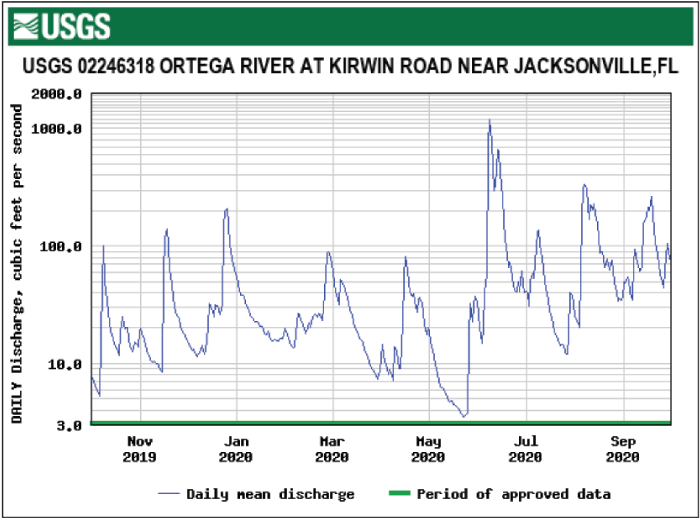
Daily mean discharge for Ortega River at Kirwin Road near Jacksonville, Florida.
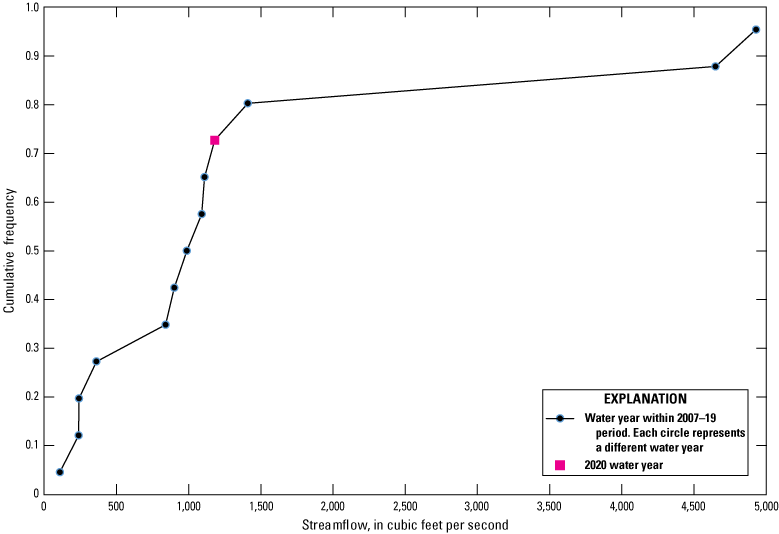
Peak streamflow at Ortega River at Kirwin Road near Jacksonville, Florida.
Ortega River salinity at Jacksonville, Florida—Salinity at Ortega River ranged from 0.0 to 13 ppt during the 2020 water year, with a median of 0.1 ppt and mean of 0.6 ppt (fig. 48). Peak maximum daily salinity values were calculated for January to May during periods of discharge below 100 ft3/s in Ortega River (fig. 46). The 2020 maximum and median salinity ranked the highest among those calculated for the 5 years of the study, and the mean salinity tied with 2019 for second (fig. 49).
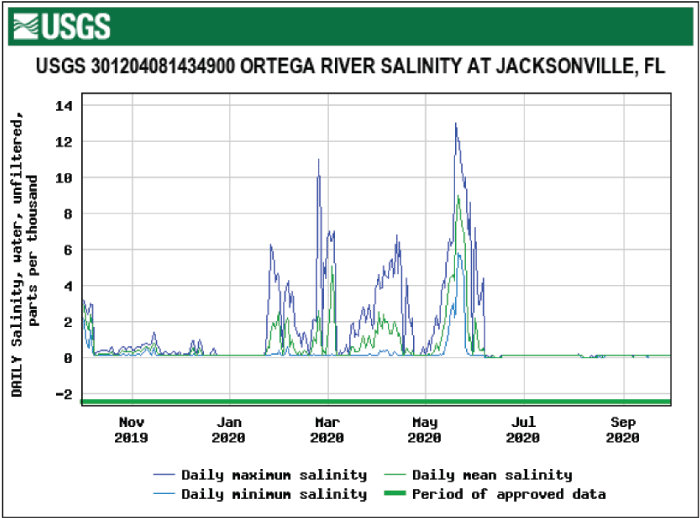
Daily maximum, minimum, and mean salinity for Ortega River salinity at Jacksonville, Florida.
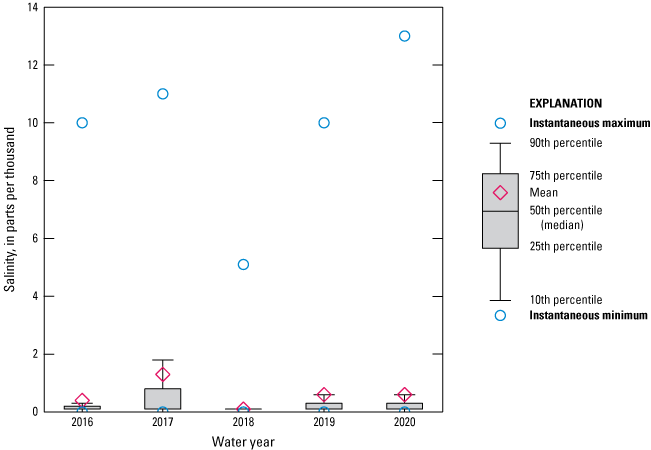
Data for Ortega River salinity at Jacksonville, Florida.
Cedar River at San Juan Avenue at Jacksonville, Florida—Daily tidally filtered discharge at Cedar River ranged from −52.9 to 1,020 ft3/s during the 2020 water year, with an annual mean of 44.2 ft3/s (fig. 50). Salinity ranged from 0.0 to 15 ppt, with a median of 1.0 ppt and mean of 2.7 ppt (fig. 51). Daily tidally filtered discharge was not calculated for 7 days in December, 3 days in January, 4 days in March, 1 day in May, 4 days in June, 3 days in August, and was estimated for 4 days in June because of equipment malfunction. As at other tributary sites, the peak discharge at Cedar River occurred during a sharp rise in June. The 2020 mean salinity ranked second among those computed for the 5 years of the study, and the median salinity ranked third (fig. 52).
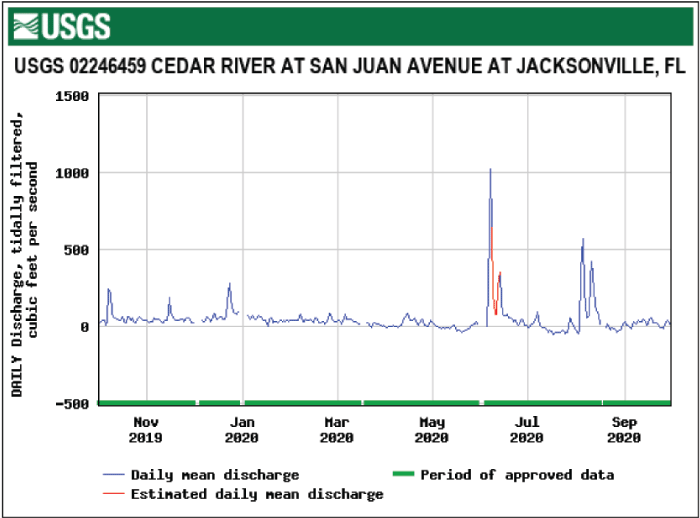
Daily mean tidally filtered discharge for Cedar River at San Juan Avenue at Jacksonville, Florida.
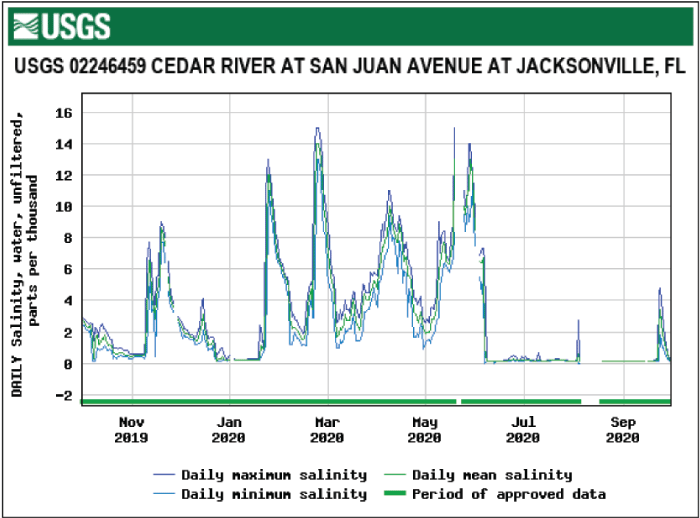
Daily maximum, minimum, and mean salinity for Cedar River at San Juan Avenue at Jacksonville, Florida.
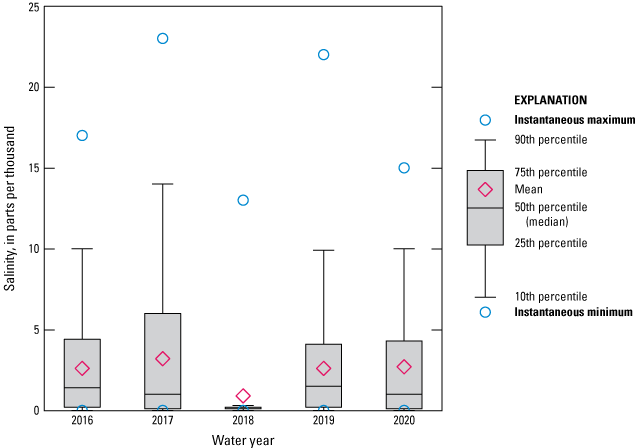
Salinity data for Cedar River at San Juan Avenue at Jacksonville, Florida.
Pottsburg Creek near South Jacksonville, Florida—Daily discharge for Pottsburg Creek at Bowden Road ranged from 1.94 to 437 ft3/s during the 2020 water year, with an annual mean flow of 26.0 ft3/s (fig. 53). Daily mean discharge peaked above 200 ft3/s in October, June, and August, all of which had above-average rainfall in Duval County (fig. 3). The peak streamflow for the period of record ranked in the 45th percentile of the 10 years of record (fig. 54).
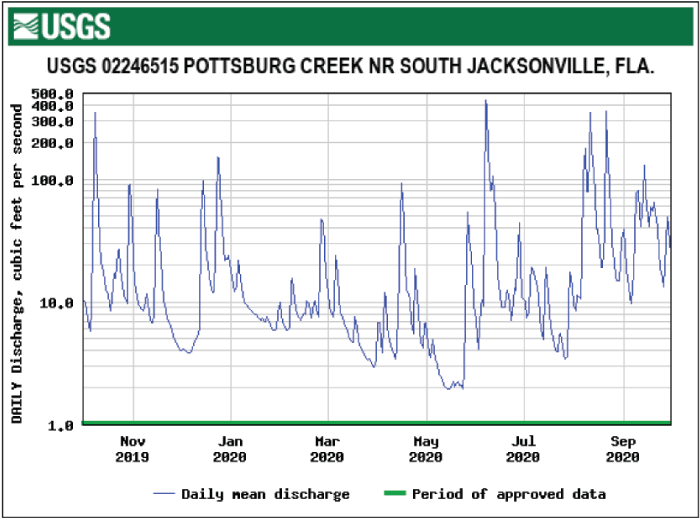
Daily mean discharge for Pottsburg Creek near South Jacksonville, Florida.

Peak streamflow at Pottsburg Creek near South Jacksonville, Florida.
Pottsburg Creek at U.S. 90 near South Jacksonville, Florida—Daily tidally filtered discharge at Pottsburg Creek at U.S. 90 ranged from −11.4 to 488 ft3/s during the 2020 water year, with an annual mean flow of 46.0 ft3/s (fig. 55). Daily tidally filtered discharge was not calculated for 3 days in October, 10 days in November, 7 days in December, and 9 days in June because of equipment malfunction. The daily discharge peaked two times over 300 ft3/s, and the peak that occurred in June was the highest since September 2017. Salinity ranged from 0.0 to 12.0 ppt, with a median of 0.4 ppt and mean of 1.1 ppt (fig. 56). Peak salinity exceeded 10 ppt for 9 consecutive days in May during periods of below-average rainfall in Duval County (fig. 3). The maximum salinity tied 2016 and 2017 for highest among those computed for the 5 years of the study, and the 2020 mean salinity tied with 2016 for second (fig. 57).
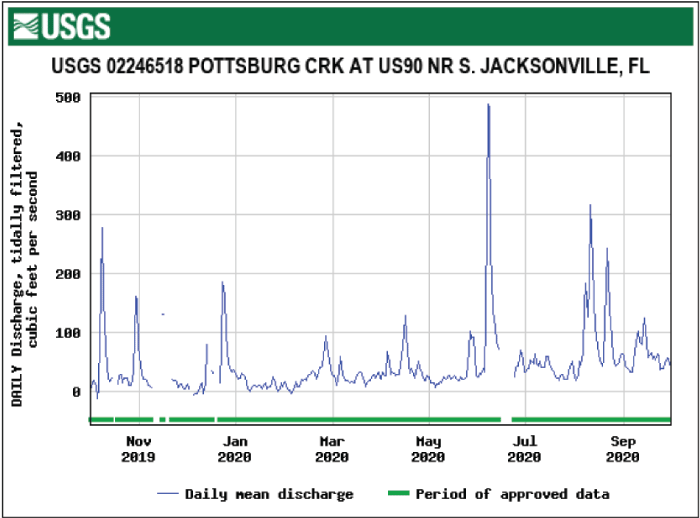
Daily mean tidally filtered discharge for Pottsburg Creek at U.S. 90 near South Jacksonville, Florida.
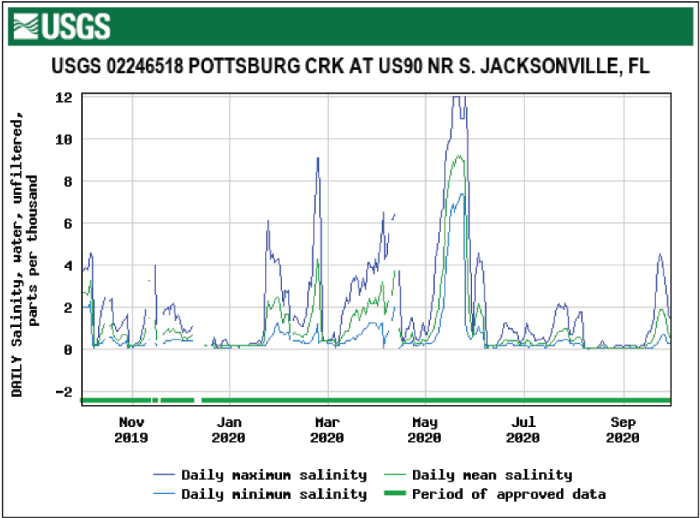
Daily maximum, minimum, and mean salinity for Pottsburg Creek at U.S. 90 near South Jacksonville, Florida.
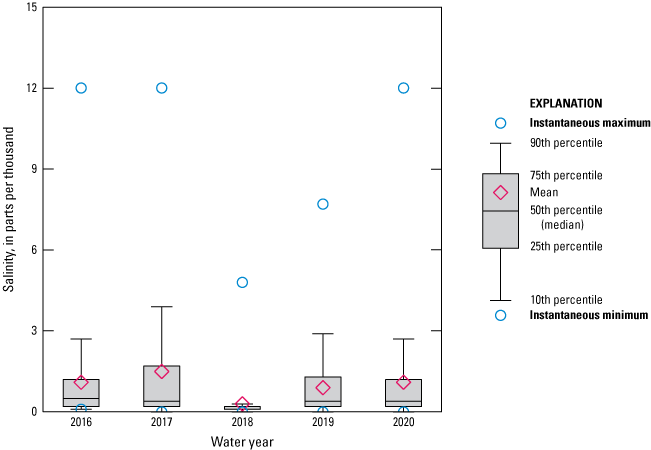
Salinity data for Pottsburg Creek at U.S. 90 near South Jacksonville, Florida.
Trout River near Jacksonville, Florida—Daily tidally filtered discharge at Trout River ranged from −320 to 1,190 ft3/s during the 2020 water year, with an annual mean flow of 35.5 ft3/s (fig. 58). Daily tidally filtered discharge was not calculated for 5 days in October and 9 days in June because of equipment malfunction. The daily discharge exceeded 600 ft3/s two times during the period, and the peak that occurred in August was the highest since September 2017.
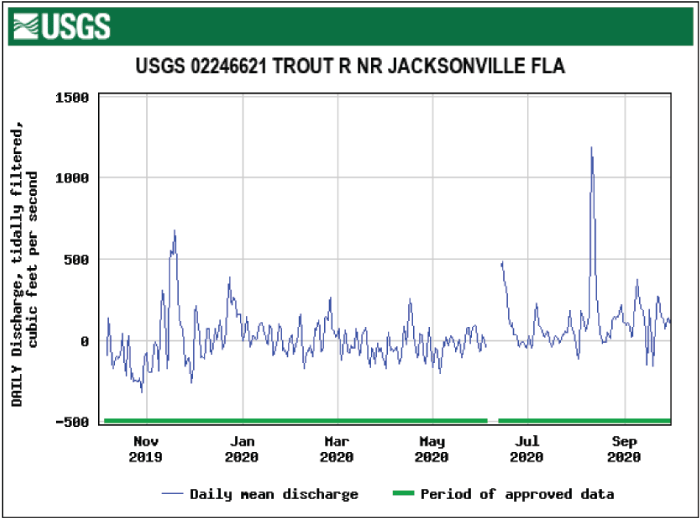
Daily mean tidally filtered discharge for Trout River near Jacksonville, Florida.
Trout River below U.S. 1 at Dinsmore, Florida—Salinity at Trout River below U.S. 1 ranged from 0.0 to 14 ppt during the 2020 water year, with a median of 0.5 ppt and mean of 2.3 ppt (fig. 59). Daily maximum salinity values peaked above 10 ppt during portions of April through June. The second-highest maximum yearly salinity of the 5-year period of record (14 ppt) occurred on multiple days in late May and early June and ended when flow increased in Trout River (fig. 58). The 2020 mean and median salinity ranked fourth among those calculated for the 5 years of the study (fig. 60).
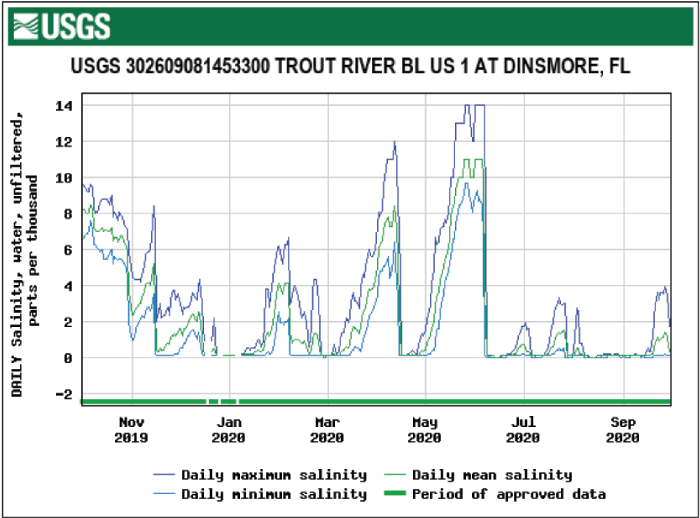
Daily maximum, minimum, and mean salinity for Trout River below U.S. 1 at Dinsmore, Florida.
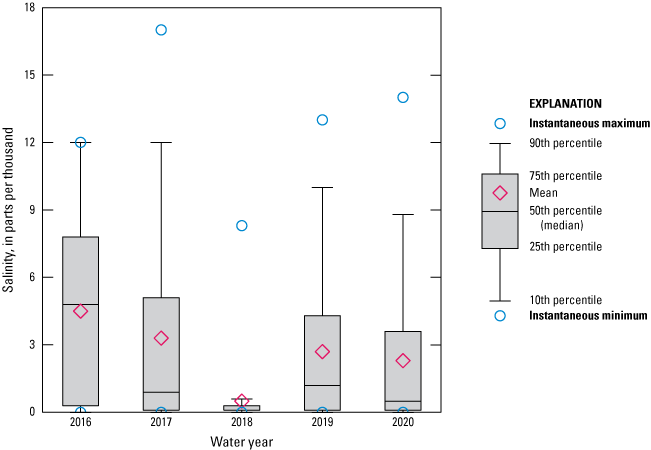
Salinity data for Trout River below U.S. 1 at Dinsmore, Florida.
Broward River below Biscayne Blvd. near Jacksonville, Florida—Daily tidally filtered discharge at Broward River ranged from −46.5 to 398 ft3/s during the 2020 water year, with an annual mean flow of 25.6 ft3/s (fig. 61). Discharge was relatively consistent during the period, with 7 peaks of daily tidally filtered discharge exceeding 100 ft3/s. Salinity ranged from 0.0 to 14 ppt, with a median of 0.6 ppt and mean of 1.7 ppt (fig. 62). Salinity remained below 6 ppt most of the year but exceeded 10 ppt in October, November, and April (fig. 62). The 2020 median, mean, and maximum salinity ranked third among those calculated for the 5 years of the study (fig. 63).
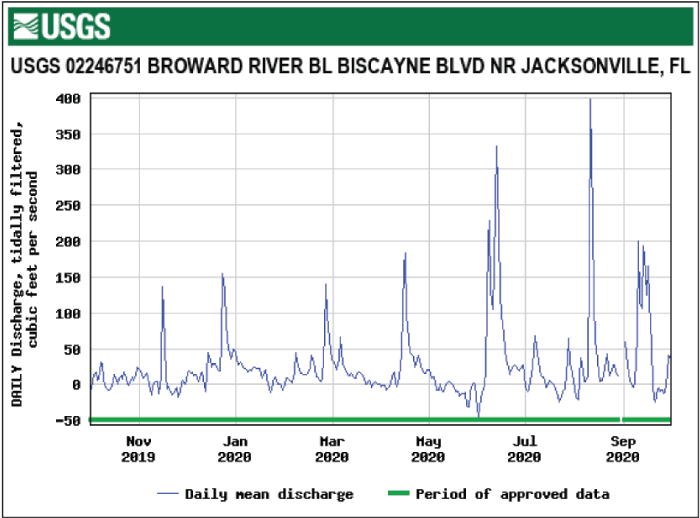
Daily mean tidally filtered discharge for Broward River below Biscayne Boulevard near Jacksonville, Florida.
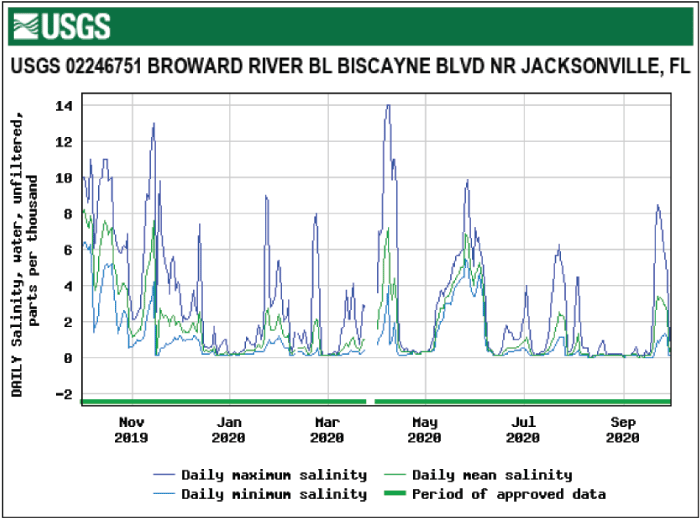
Daily maximum, minimum, and mean salinity for Broward River below Biscayne Boulevard near Jacksonville, Florida.
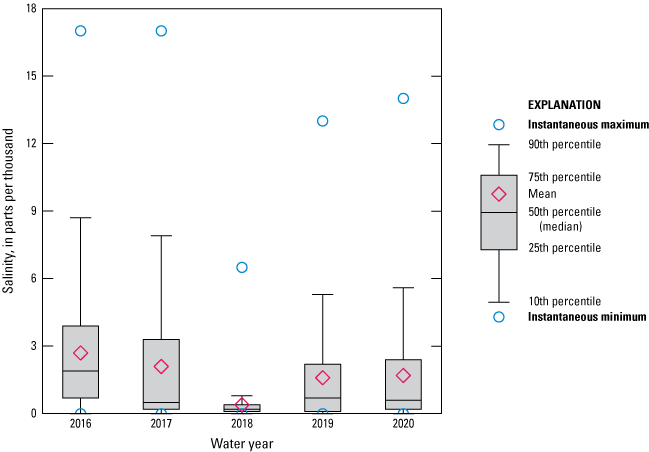
Salinity data for Broward River below Biscayne Boulevard near Jacksonville, Florida.
Dunn Creek at Dunn Creek Road near Eastport, Florida—Daily tidally filtered discharge at Dunn Creek ranged from −5.62 to 172 ft3/s during the 2020 water year, with an annual mean flow of 25.8 ft3/s (fig. 64). Daily tidally filtered discharge was estimated for 5 days in December because of equipment malfunction. The cumulative 4-month rainfall in Duval County was 3.62 in. above the long-term average from June to September, and the daily tidally filtered discharge peaked over 100 ft3/s five times in that period (fig. 3). Salinity during the 2020 water year ranged from 0.0 to 17 ppt, with a median of 1.9 ppt and mean of 3.1 ppt (fig. 65). Daily maximum salinity exceeded 15 ppt for 8 days from April to May and remained below 7 ppt from mid-June to mid-September. The 2020 maximum and mean salinity tied with 2016 for second among those calculated for the 5 years of the study, and the median salinity ranked third (fig. 66). Salinity was not calculated for 2 days in April because of equipment malfunction.
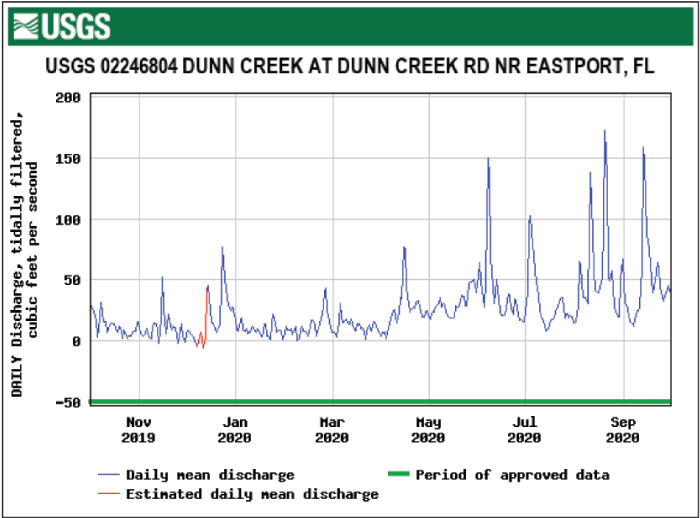
Daily mean tidally filtered discharge for Dunn Creek at Dunn Creek Road near Eastport, Florida.
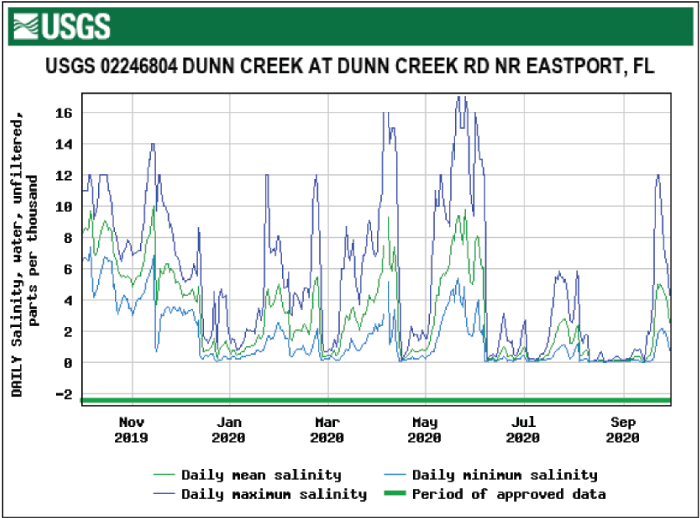
Daily maximum, minimum, and mean salinity for Dunn Creek at Dunn Creek Road near Eastport, Florida.
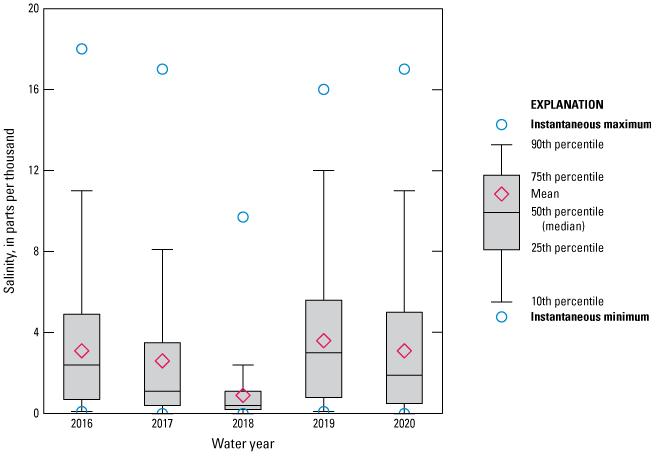
Salinity data for Dunn Creek at Dunn Creek Road near Eastport, Florida.
Clapboard Creek near Jacksonville, Florida—Daily tidally filtered discharge at Clapboard Creek ranged from −74.1 to 278 ft3/s during the 2020 water year, with an annual mean flow of 61.3 ft3/s (fig. 67). Tidally filtered discharge remained below 200 ft3/s for the entire period except during two peaks in October and two in September. The highest peak flow in September ranked second, and the annual mean flow ranked first for the 5-year period of record considered for this study.
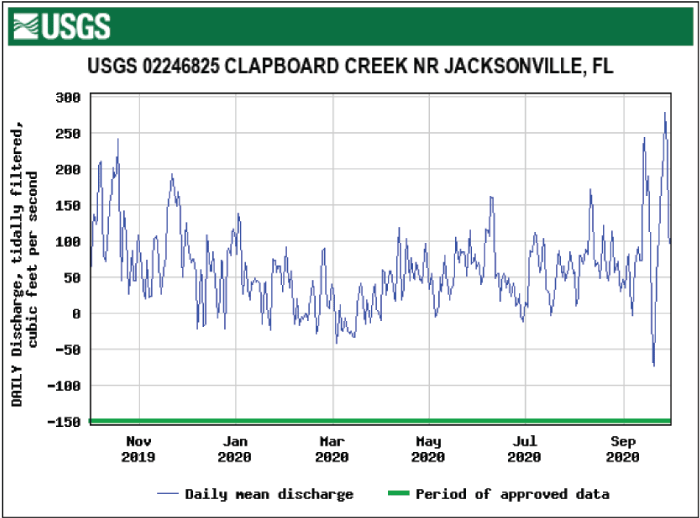
Daily mean tidally filtered discharge for Clapboard Creek near Jacksonville, Florida.
Clapboard Creek above Buckhorn Bluff near Jacksonville, Florida—Salinity at Clapboard Creek ranged from 1.0 to 32 ppt during the 2020 water year, with a median of 21 ppt and mean of 20 ppt (fig. 68). The lowest salinity occurred in September when discharge increased through Clapboard Creek (fig. 67). The 2020 mean salinity ranked fourth among those calculated for the 5 years of the study, and the median salinity tied with 2017 and 2019 for second (fig. 69).
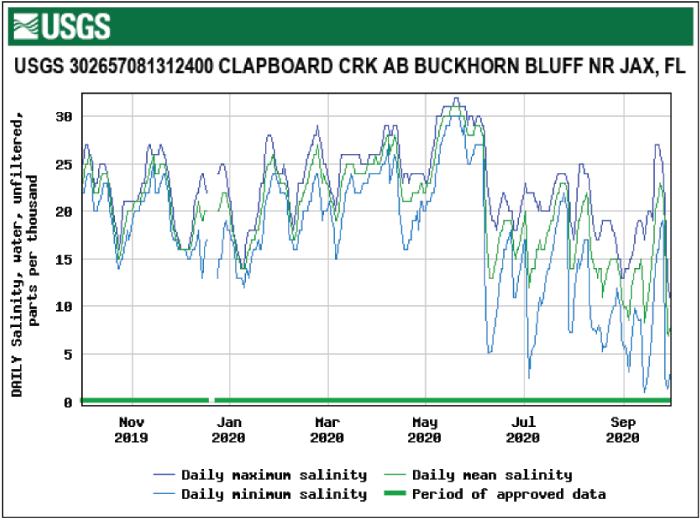
Daily maximum, minimum, and mean salinity for Clapboard Creek above Buckhorn Bluff near Jacksonville, Florida.
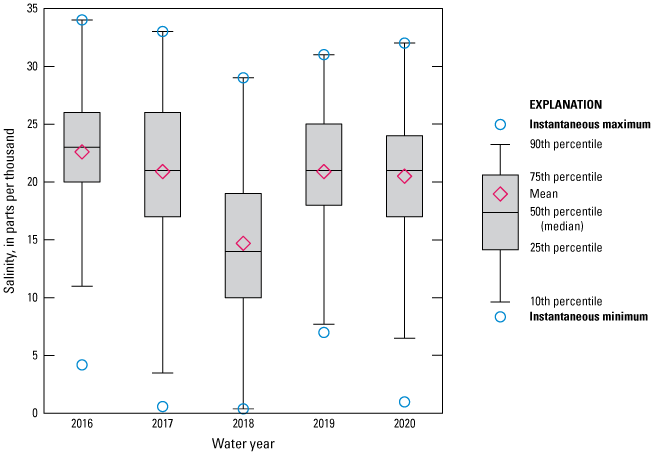
Salinity data for Clapboard Creek above Buckhorn Bluff near Jacksonville, Florida.
Discharge and Salinity Site Comparison
Analysis of the annual mean tidally filtered discharge for the 2020 water year along the main stem of the St. Johns River indicates that streamflow increased with distance downstream, as expected (fig. 70). Relative to the 2019 water year, annual mean discharge for the 2020 water year was higher for two of the main-stem sites and identical for the other site. Over the 5 years considered for this study, the second-highest annual mean discharge was computed at the St. Johns River at Astor site , the Buffalo Bluff site tied for second, and the Jacksonville site ranked third. Of the tributaries, annual mean discharge was highest at Clapboard Creek, followed by Ortega River, Durbin Creek, Pottsburg Creek at U.S. 90, Cedar River, Trout River, Julington Creek, Pottsburg Creek near South Jacksonville, Dunn Creek, and Broward River, whose annual mean was lowest (fig. 71). Annual mean discharge at 8 of the 10 tributary monitoring sites was higher for the 2020 water year than for the 2019 water year, and the computed annual mean flow at Clapboard Creek was the highest over the 5 years considered for this study (fig. 71). The countywide annual rainfall for the 2020 water year was above the average in three of the five counties, higher in three of the five counties for the 2020 water year relative to the 2019 water year, and ranked third among the annual rainfall totals for the past 5 years (fig. 72).
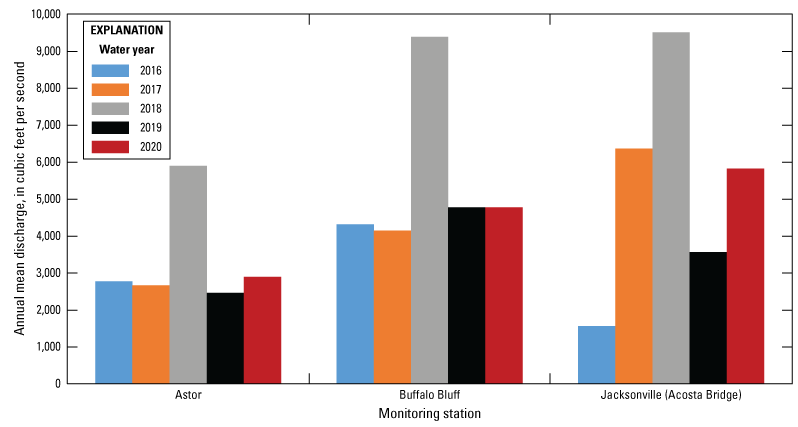
Annual mean tidally filtered discharge at St. Johns River main-stem monitoring sites.
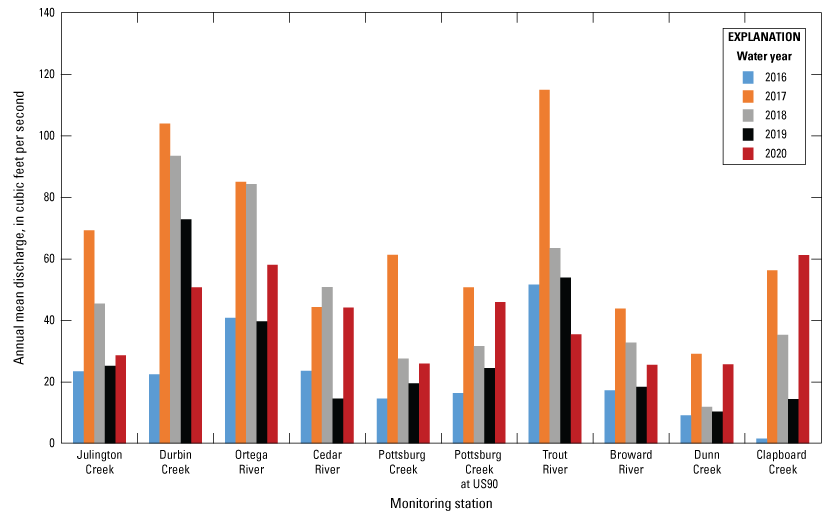
Annual mean discharge at St. Johns River tributary monitoring sites.
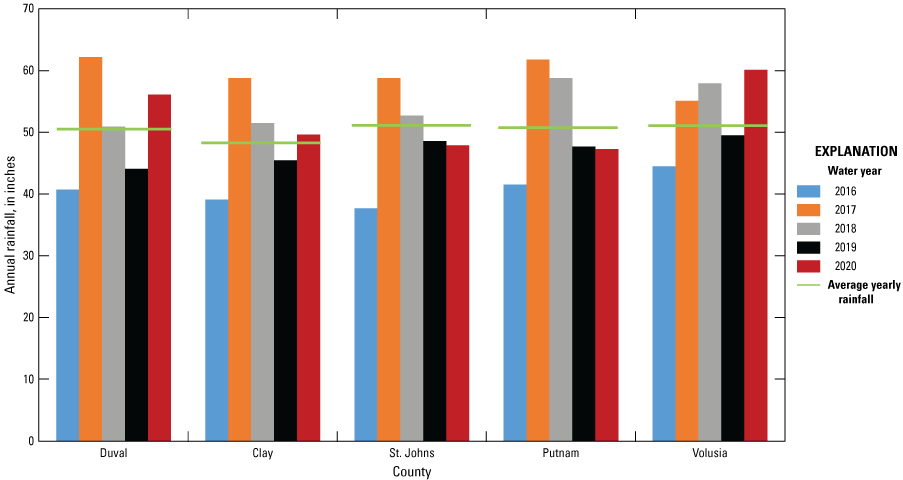
Annual rainfall for Duval, Clay, St. Johns, Putnam, and Volusia Counties.
Annual mean salinity for the main-stem sites generally decreased with distance upstream, which was expected (fig. 73). Of all sites in 2020, Dames Point had the highest annual mean salinities, which were 22 ppt near the surface and 23 ppt near the bottom of the water column. The 2020 annual mean salinity was higher than that of 2019 at all main-stem sites (fig. 73). The 2020 salinity at the main-stem sites, when compared to all 5 years of the study, ranked first at Dancy Point, Racy Point, Shands Bridge, below Shands Bridge, above Buckman Bridge, and at Jacksonville (Acosta Bridge), tied for first at Buffalo Bluff, second at Buckman Bridge (top and bottom) and Dames Point (top and bottom), and third at Christopher Point and Marco Lake.
Clapboard Creek had the highest annual mean salinity (20 ppt) of all tributaries in 2020 because of its proximity to the Atlantic Ocean. Durbin Creek salinity (0.1 ppt) was the lowest of all monitoring locations and was slightly lower than those of Julington Creek and Ortega River (both 0.6 ppt) (fig. 74). A simple comparison of annual mean salinity of tributary sites between the 2019 and 2020 water years indicates salinity was higher in 2020 at all locations except Trout River, Dunn Creek, and Clapboard Creek, which were lower, and Durbin Creek, which remained the same (fig. 74). The 2020 salinity at the tributary sites, when compared to the preceding 4 years of the study, ranked second at Ortega River and Julington Creek, tied for second at Dunn Creek, ranked third at Cedar River, Pottsburg Creek, and Broward River, and ranked fourth at Trout River and Clapboard Creek. Durbin Creek salinity remained the same at 0.1 ppt for all 5 years. The annual rainfall total for Duval County ranked second among those computed for the 5 years considered for this study (fig. 72).
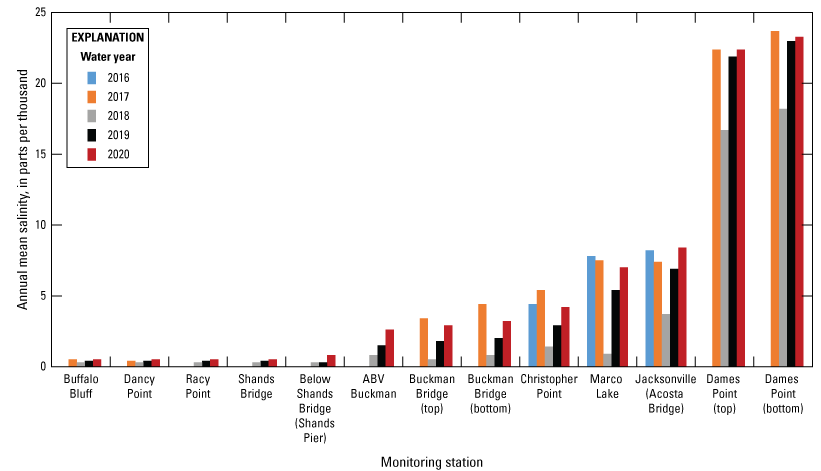
Annual mean salinity at St. Johns River main-stem monitoring sites.
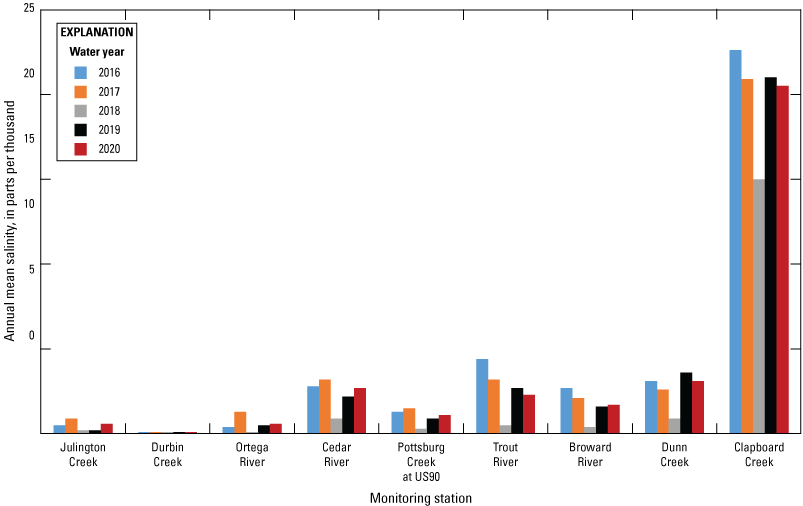
Annual mean salinity at St. Johns River tributary monitoring sites.
Summary
The U.S. Geological Survey, in cooperation with the U.S. Army Corps of Engineers, collected data during the 2020 water year, from October 2019 to September 2020, at 26 sites on the St. Johns River and its tributaries. This period of data collection was concurrent with river dredging, which was initiated in February 2018 by the U.S. Army Corps of Engineers as part of its project to deepen the first 13 river miles of Jacksonville Harbor. Data collection began in the 2016 water year, and this is the fifth annual report of the study. Stage was measured at 17 sites, discharge was calculated at 13 sites, and water temperature and specific conductance data were collected at 20 sites; all parameters were measured at some sites. Salinity was calculated for each site where water temperature and specific conductance data were collected. Data were collected over a range of hydrologic conditions, including a period of above-average annual rainfall in Duval, Clay, and Volusia Counties. Many factors—such as wind, rainfall, and hurricanes—can influence flow and salinity within the study area.
The annual mean tidally filtered discharge for the 2020 water year increased with distance downstream, as expected, along the main stem of the St. Johns River. The second-highest annual mean discharge was computed at the St. Johns River at Astor site over the 5 years considered for this study, while the Buffalo Bluff site tied for second, and the Jacksonville site ranked third. The 2020 annual mean salinity was higher than that of 2019 at all main-stem sites. The 2020 salinity at the main-stem sites, when compared to all 5 years of the study, ranked first at Dancy Point, Racy Point, Shands Bridge, below Shands Bridge, above Buckman Bridge, and at Jacksonville (Acosta Bridge), tied for first at Buffalo Bluff, ranked second at Buckman Bridge (top and bottom) and Dames Point (top and bottom), and ranked third at Christopher Point and Marco Lake.
Of the tributaries, annual mean discharge was highest at Clapboard Creek, followed by Ortega River, Durbin Creek, Pottsburg Creek at U.S. 90, Cedar River, Trout River, Julington Creek, Pottsburg Creek near South Jacksonville, Dunn Creek, and Broward River, whose annual mean was lowest. Annual mean discharge at 8 of the 10 tributary monitoring sites was higher for the 2020 water year than for the 2019 water year, and the highest annual mean flow was computed at Clapboard Creek over the 5 years considered for this study. Annual mean salinity at all tributary sites in the 2020 water year was higher than that of the 2019 water year except for Trout River, Dunn Creek, and Clapboard Creek, which were lower, and Durbin Creek, which remained the same. The 2020 salinity at the tributary sites, when compared to all 5 years of the study, ranked second at Ortega River and Julington Creek, tied for second at Dunn Creek, ranked third at Cedar River, Pottsburg Creek, and Broward River, and ranked fourth at Trout River and Clapboard Creek. Durbin Creek salinity remained the same at 0.1 ppt for all 5 years. The annual rainfall total for Duval County ranked second among those computed for the 5 years considered for this study.
References Cited
Jacksonville Port Authority [JAXPORT], 2018, Jacksonville harbor deepening fact sheet: 1 p., accessed March 21, 2019, at https://www.jaxport.com/sites/default/files/images/HarborDeepeningInfo_1.pdf.
Levesque, V.A., and Oberg, K.A., 2012, Computing discharge using the index velocity method: U.S. Geological Survey Techniques and Methods, book 3, chap. A23, 148 p. [Also available at https://pubs.usgs.gov/tm/3a23/.]
Ryan, P.J., 2018, Continuous stream discharge, salinity, and associated data collected in the lower St. Johns River and its tributaries, Florida, 2016: U.S. Geological Survey Open-File Report 2018–1108, 28 p., accessed March 20, 2020, at https://doi.org/10.3133/ofr20181108.
Ryan, P.J., 2019, Continuous stream discharge, salinity, and associated data collected in the lower St. Johns River and its tributaries, Florida, 2017: U.S. Geological Survey Open-File Report 2019–1078, 35 p., accessed March 20, 2020, at https://doi.org/10.3133/ofr20191078.
Ryan, P.J., 2020a, Continuous stream discharge, salinity, and associated data collected in the lower St. Johns River and its tributaries, Florida, 2018: U.S. Geological Survey Open-File Report 2020–1061, 34 p., accessed July 9, 2020, at https://doi.org/10.3133/ofr20201061.
Ryan, P.J., 2020b, Continuous stream discharge, salinity, and associated data collected in the lower St. Johns River and its tributaries, Florida, 2019: U.S. Geological Survey Open-File Report 2020–1140, 48 p., accessed May 26, 2021, at https://doi.org/10.3133/ofr20201140.
Sauer, V.B., and Turnipseed, D.P., 2010a, Stage measurement at gaging stations: U.S. Geological Survey Techniques and Methods, book 3, chap. A7, 45 p. [Also available at https://doi.org/10.3133/tm3A7.]
Sauer, V.B., and Turnipseed, D.P., 2010b, Discharge measurements at gaging stations: U.S. Geological Survey Techniques and Methods, book 3, chap. A8, 87 p. [Also available at https://doi.org/10.3133/tm3A8.]
St. Johns River Water Management District [SJRWMD], 2021, Rainfall summary—Hydrologic conditions report: St. Johns River Water Management District report, 1 p., accessed May 26, 2021, at http://webapub.sjrwmd.com/agws10/hydroreport/.
U.S. Army Corps of Engineers, [USACE], 2014, Jacksonville Harbor navigation study, Duval County, Florida: U.S. Army Corps of Engineers, Jacksonville District, Final integrated general reevaluation report II and supplemental environmental impact statement, 289 p. [Also available at https://usace.contentdm.oclc.org/digital/collection/p16021coll7/id/2118.]
U.S. Geological Survey, [USGS], 2021, USGS water data for the Nation: U.S. Geological Survey National Water Information System database, accessed May 2021 at https://doi.org/10.5066/F7P55KJN.
Wagner, R.J., Boulger, R.W., Jr., Oblinger, C.J., and Smith, B.A., 2006, Guidelines and standard procedures for continuous water-quality monitors—Station operation, record computation, and data reporting: U.S. Geological Survey Techniques and Methods, book 1, chap. D3, 51 p. [Also available at https://pubs.usgs.gov/tm/2006/tm1D3/pdf/TM1D3.pdf.]
Conversion Factors
Datum
Vertical coordinate information is referenced to the North American Vertical Datum of 1988 (NAVD 88).
Horizontal coordinate information is referenced to the North American Datum of 1983 (NAD 83).
Altitude, as used in this report, refers to distance above the vertical datum.
Supplemental Information
Specific conductance is given in microsiemens per centimeter at 25 degrees Celsius (µS/cm at 25 °C).
For more information about this publication, contact
Director, Caribbean-Florida Water Science Center
U.S. Geological Survey
4446 Pet Lane, Suite 108
Lutz, FL 33559
For additional information, visit
https://www.usgs.gov/centers/car-fl-water
Publishing support provided by
Lafayette Publishing Service Center
Suggested Citation
Ryan, P.J., 2022, Continuous stream discharge, salinity, and associated data collected in the lower St. Johns River and its tributaries, Florida, 2020: U.S. Geological Survey Open-File Report 2022–1024, 48 p., https://doi.org/10.3133/ofr20221024.
ISSN: 2331-1258 (online)
Study Area
| Publication type | Report |
|---|---|
| Publication Subtype | USGS Numbered Series |
| Title | Continuous stream discharge, salinity, and associated data collected in the lower St. Johns River and its tributaries, Florida, 2020 |
| Series title | Open-File Report |
| Series number | 2022-1024 |
| DOI | 10.3133/ofr20221024 |
| Year Published | 2022 |
| Language | English |
| Publisher | U.S. Geological Survey |
| Publisher location | Reston, VA |
| Contributing office(s) | Caribbean-Florida Water Science Center |
| Description | Report: ix, 48 p.; Dataset |
| Country | United States |
| State | Florida |
| Other Geospatial | St. Johns River |
| Online Only (Y/N) | Y |
| Google Analytic Metrics | Metrics page |


